Early Power Distribution
The following collection of historical photographs depicts the evolution of Power Distribution methods, procedures, and equipment as used by the Los Angeles Department of Water and Power and other local utilities in providing electric service to its customers. |
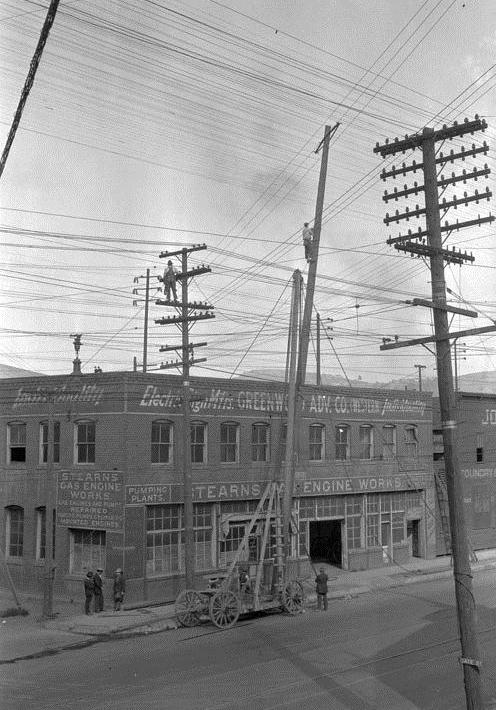 |
|
| (Early 1900s)* - View showing Los Angeles Bureau of Power and Light workers setting new pole using a horse-drawn pole-setting wagon. Note the two linemen high up on the existing and new poles. |
Historical Notes The name 'Department of Water and Power (DWP)' did not come about until 1937 when the City's Bureau of Water Works and Supply consolidated with the Bureau of Power and Light. Click HERE to see Name Change Chronology of DWP. |
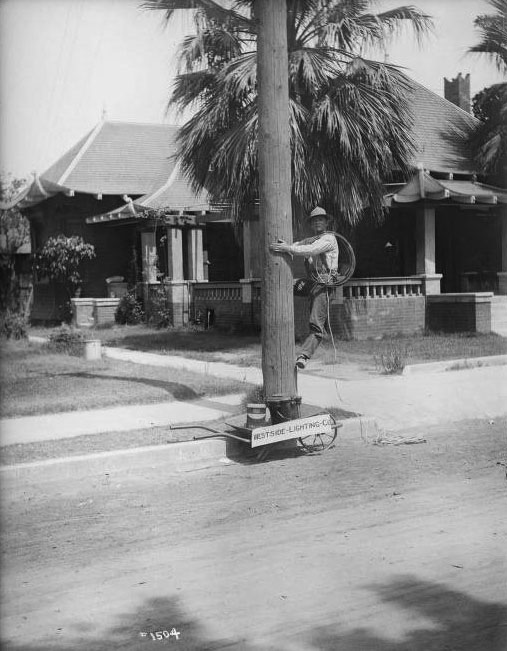 |
|
| (1912)^# - Sam Darnell, Westside Lighting Company's first lineman, demonstrating how he climbed poles for the Westside Lighting Company before it evolved into the Southern California Edison Company. |
Historical Notes West Side Lighting Company was organized in 1896 by private investors to provide another source of electricity for fringe areas of the city of Los Angeles. Click HERE to see more. |
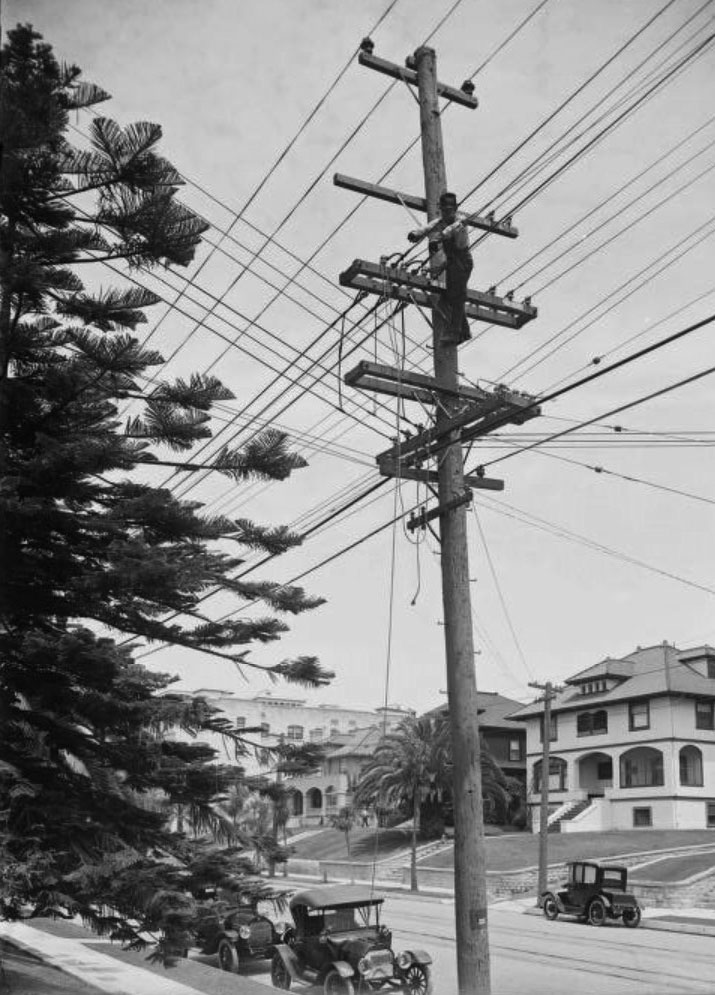 |
|
| (1915)^# – Photo caption reads: "Safety First" - making a tie without protectors. View shows a SCE Lineman working on a congested power pole with early model cars parked below. Note the car parked across the street. It’s an electric vehicle (see below). |
Historical Notes Electric cars might seem like the vehicles of the future, but they are actually a status symbol of the past. During the early years of the “Automotive Age,”—from about 1896 to 1930—as many as 1,800 different car manufacturers functioned in the U.S. While innovators in Europe had been working on battery-powered vehicles since the 1830s, the first successful electric car in the U.S. made its debut in 1890. The production of electric cars peaked in 1912. And while at the turn of the century electric cars had made up a good proportion of the market, advances in gasoline-powered vehicles meant that electric cars owned a smaller and smaller market share as time went on. By 1935, electric cars had all but disappeared from the road.^ |
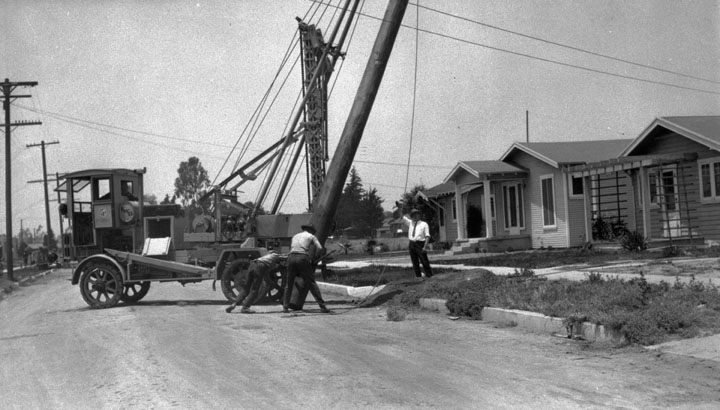 |
|
| (1915)* - Pole being set in a residential neighborhood by a Bureau of Power and Light crew. The truck being used is FWD Model B, 3-ton trucks. One of the 1st 4x4 trucks. |
Historical Notes One of the earliest and most successful production 4x4s trucks (as seen above) was the FWD Model B, a 3-ton truck that was in production from 1912 to well into the ’20s, but it was sold refurbished up to at least 1939. Not only did it become a benchmark and cornerstone product for the FWD Corporation, it became a benchmark in the growth and development of four-wheel drive in general.^ |
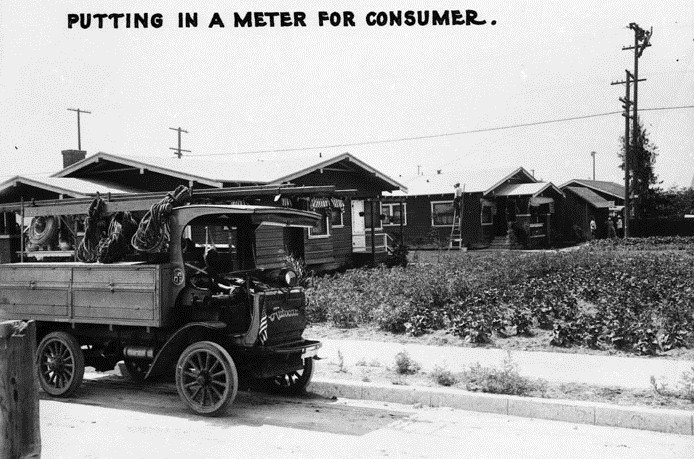 |
|
| (ca. 1917)* - Installing new overhead service. A lineman can be seen on top of the pole in the background. Note the early model truck (Moreland Truck). |
Historical Notes The Moreland Motor Truck Company of Burbank, was originally located in Los Angeles. The company slogan was "Built in the West -- for Western Work".^ |
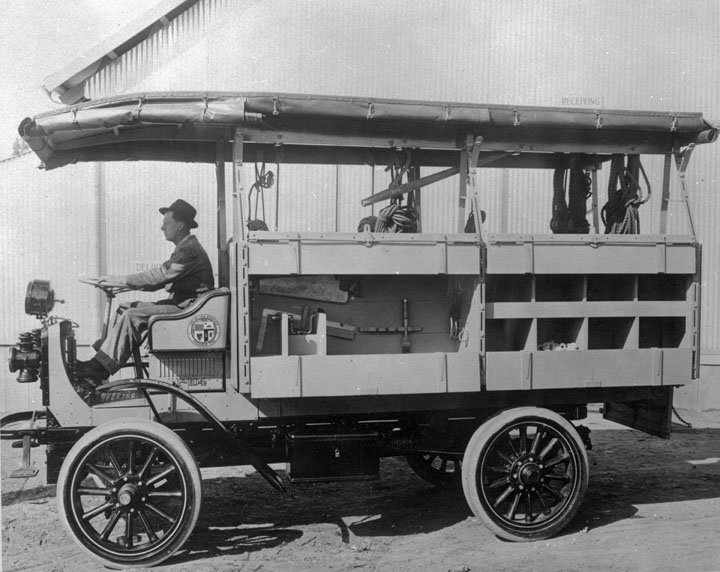 |
|
| (ca. 1920)* - Bureau of Power and Light electrical repair truck. The tool compartments are neatly stacked on the side of the truck. |
Historical Notes The above truck has been identified as a 4 cylinder Autocar with engine under the seat.^ |
Power Poles
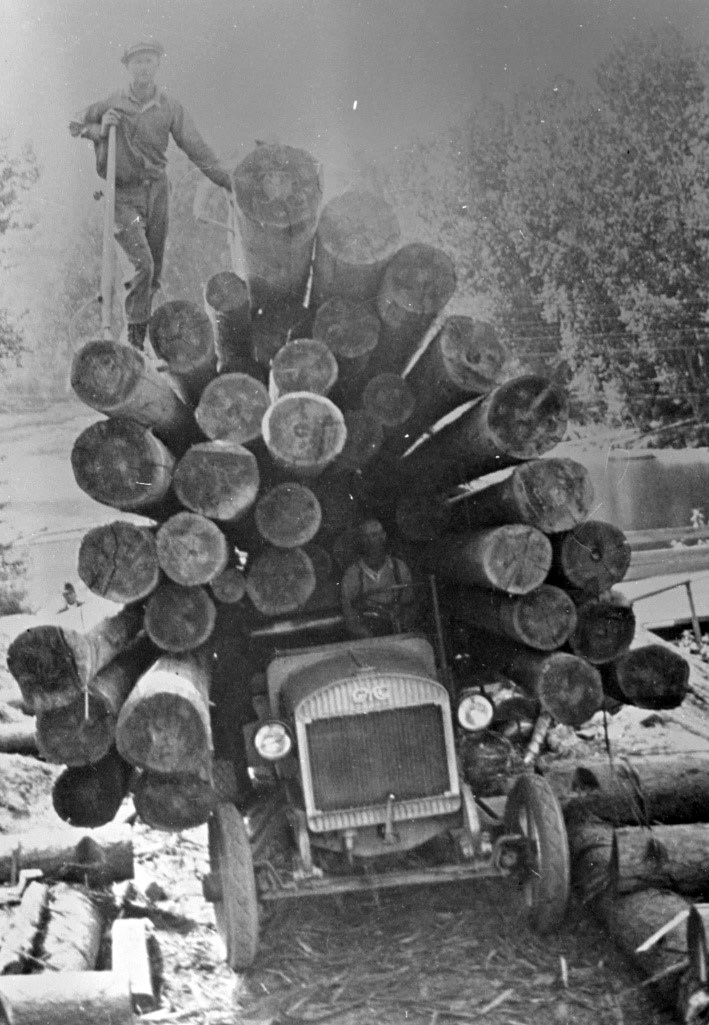 |
|
| (1920s)** – An overloaded GMC logging truck carries it’s payload of logs to the mill before they are transported by rail to Los Angeles. |
Historical Notes The first documented use of wood poles was in 1844 with the development of the telegraph. Samuel Morse received a $30,000 grant from the U.S. Congress to construct a 40-mile telegraph line between Baltimore and Washington D.C. Morse originally tried to put his new telegraph lines underground, but in the first few miles the lines failed. So he turned to placing the lines overhead and advertised to buy 700 “straight and sound” wood poles. By the turn of the century, the need emerged to have standards to create a consistent supply of wood utility poles with predictable structural capabilities. In 1908, standards for round timbers were developed and soon after, the American National Standards Institute, or ANSI, adopted standards specifically for wood utility poles, defining the sizes and characteristics allowed. Over the same time, standards for pressure treating wood with preservatives to extend their service life were developed through the American Wood Protection Association, or AWPA.* |
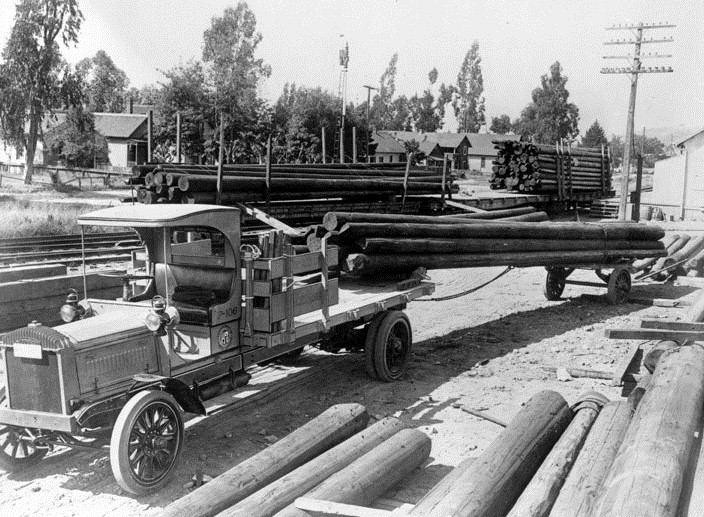 |
|
| (1920s)* - Early Bureau of Power and Light truck (Moreland truck) transporting power poles. Note the railroad cars full of poles in the background. |
Historical Notes The Moreland Motor Truck Company of Burbank, was originally located in Los Angeles. The company slogan was "Built in the West -- for Western Work". Moreland Motor Truck Co. was established in 1911, and by 1924 were offering a range of trucks from 1 1/2 ton to 6 tons capacity. In 1925 the company introduced a 6 wheel chassis (tandem rear axle) with a capacity of 10 tons. While a common feature on trucks today, Moreland was one of the first to offer a 3 axle truck. The company did well during the 1920s, but sales plummeted during the depression. By the mid 1930s the company was selling less than 50 trucks a year, down from a peak of nearly 1000. The company began to offer diesel engines and trucks up to 21 tons in the late 1930s. In 1941 truck production ended and Moreland became a parts and service company. Moreland went out of business in 1949.^ |
Overhead Line Congestion
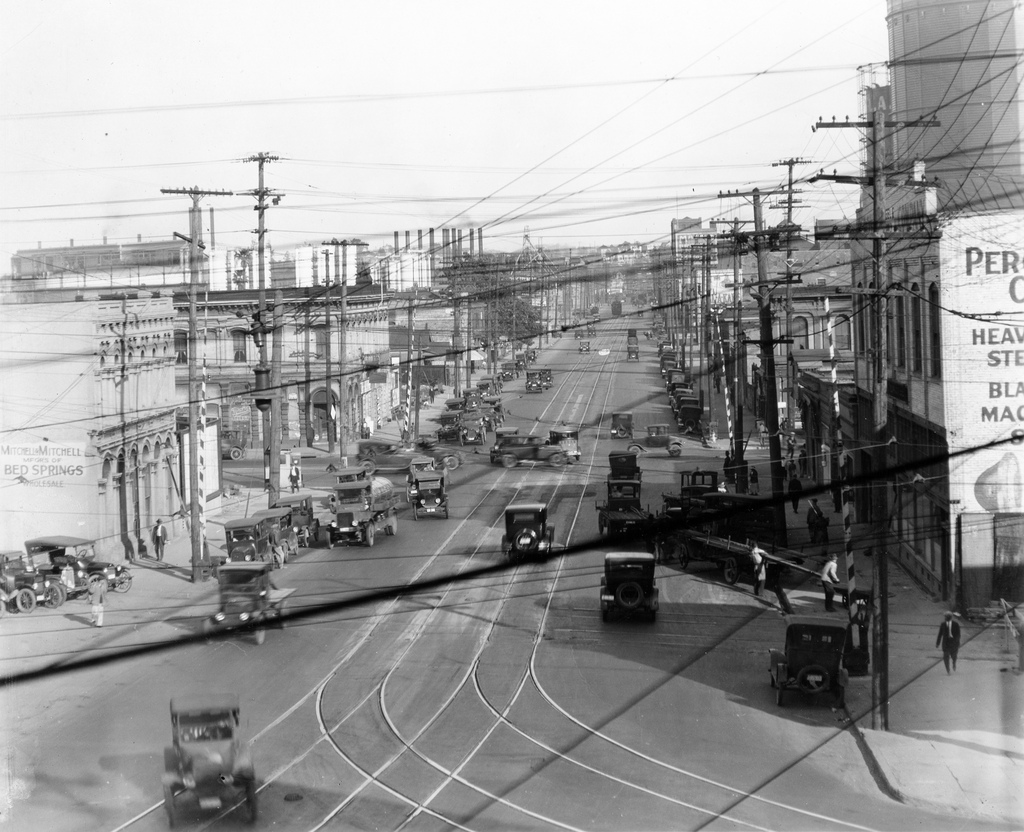 |
|
| (ca. 1925)^^ - This photograph depicts a view of Aliso Street looking East where Pacific Electric Railway Company tracks turn onto the thoroughfare from San Pedro Street. The one thing that stands out is the overhead distribution line congestion prevalent throughout. |
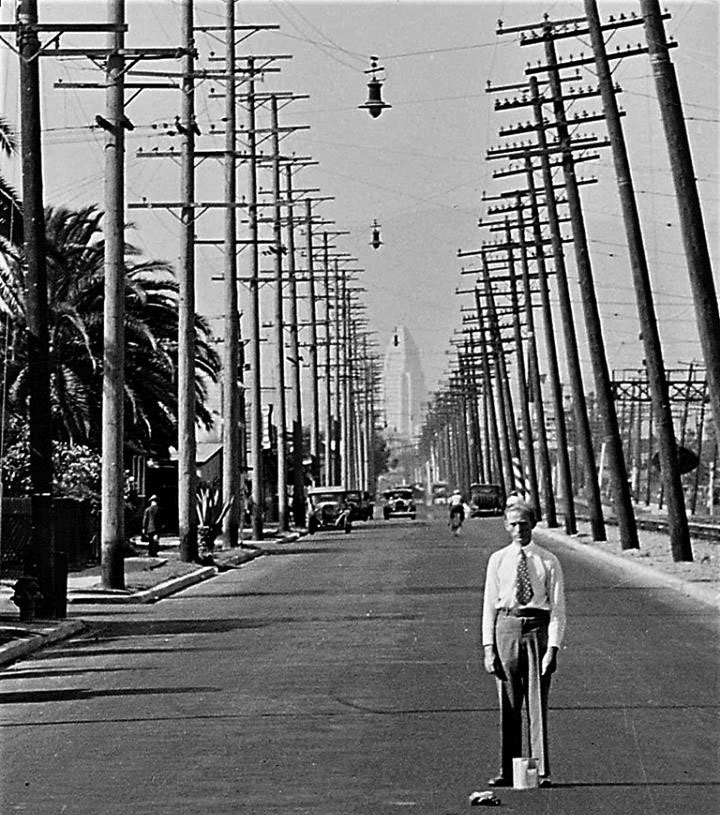 |
|
| (1929)^x^ – View looking north on Long Beach Ave at 42nd Street, showing a very serious looking man standing in the middle of the road. Overhead lines run up and down both sides of the street (power lines on the left and telephone lines on the right). Overhead utilitarian streetlights straddle the street between the lines. Railroad tracks are on the right and City Hall (built in 1928) can be seen in the distance. Click HERE to see contemporary view. |
* * * * * |
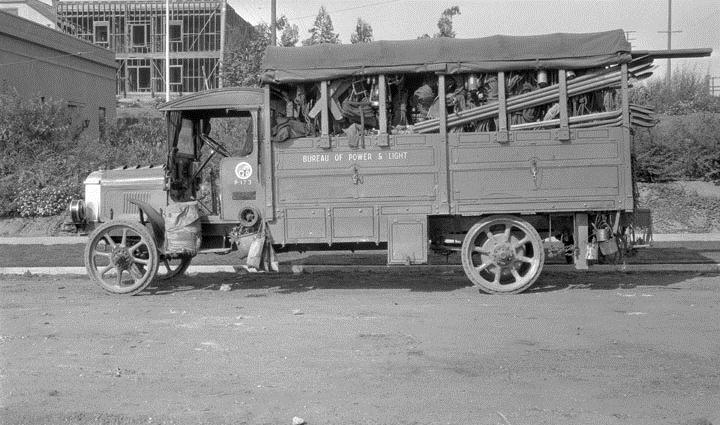 |
|
| (1926)* - Bureau of Power and Light 'Heavy Gang' truck. The truck appears to be filled to the brim with tools and equipment. |
Historical Notes The truck above appears to be a 1920's Fageol (perhaps a 5 ton). |
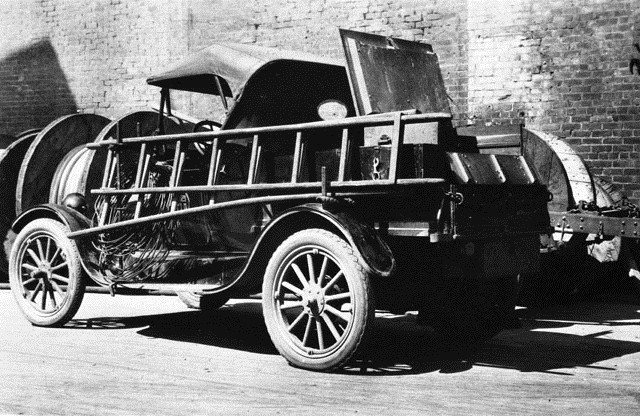 |
|
| (1927)* - Model "T" Ford used as a service truck. Note how the ladder and cable are supported by brackets on the side of the car. |
Historical Notes Model T trucks were made available from the factory in 1925. The Runabout truckmarked the first time Ford had offered a factory installed a pickup bed. Responding to increased competition, Ford launched the 1926-1927 Model T Fords as a "NewFord," but in effect, under the surface, it was the same old Model T. |
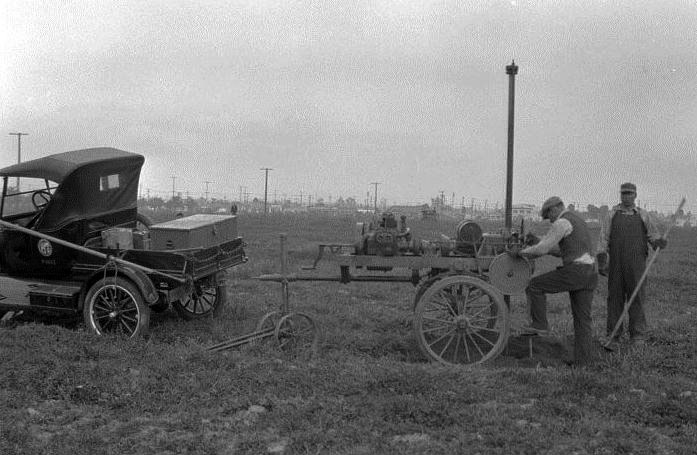 |
|
| (ca. 1927)* - View showing two men using an early piece of equipment used to drill holes for new poles. Model "T" Ford appears to have towed the equipment to the site. |
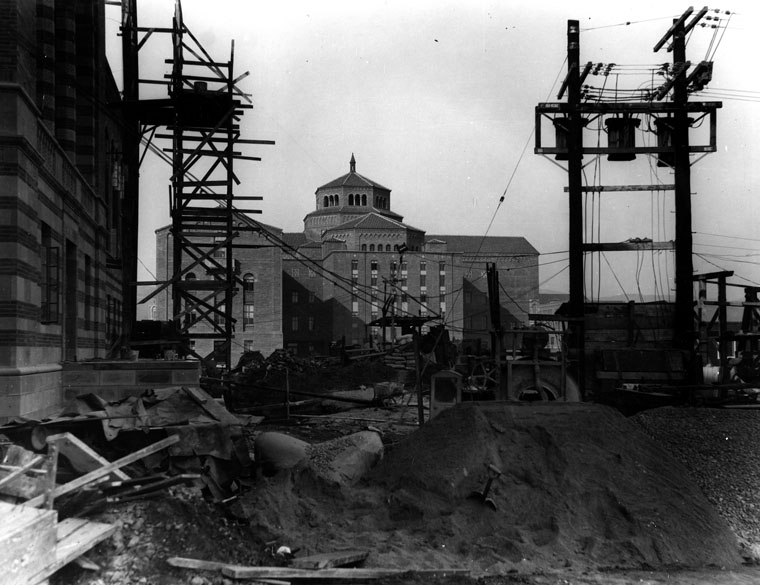 |
|
| (1929)*^ - A temporary power pole rack can be seen providing electricity for the construction of buildings at the new UCLA campus in Westwood. Click HERE to see more Early Views of UCLA. |
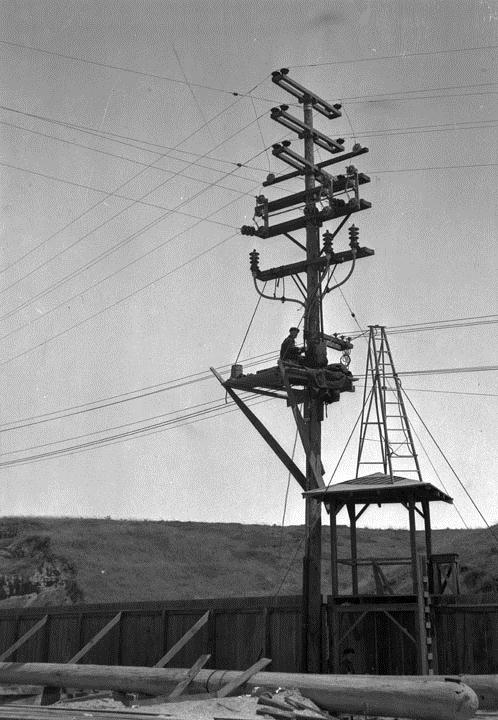 |
|
| (n.d.)* - Early Bureau of Power and Light lineman sitting on a temporary platform while splicing overhead to underground cable. Note the method used to secure the ladder. |
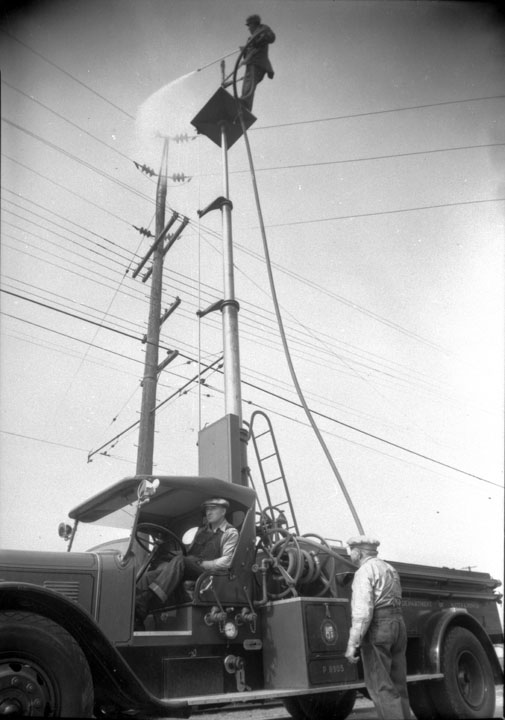 |
|
| (1932)* - A 3-man crew in a Morlenad truck in the process of washing insulators. Note the telescopic platform extension. |
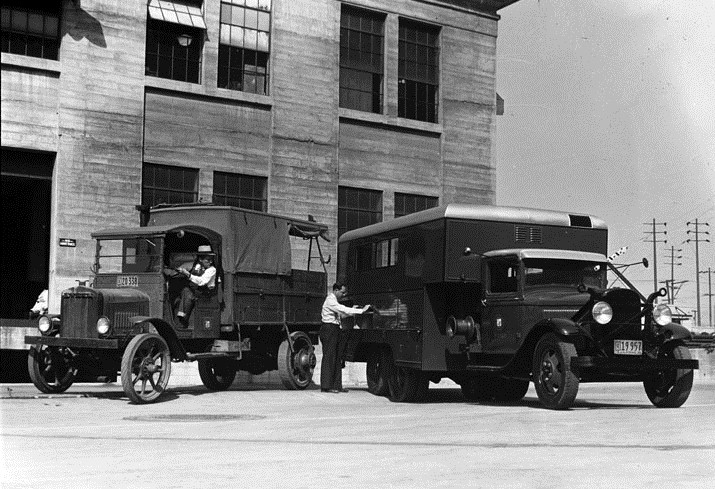 |
|
| (1936)* - New automotive unit recently turned over to the Transportation section. It was designed by the Engineering section of the General Plant division and fabricated in the machine shop at 1630 N. Main. One of two new units for the Overhead section. It is equipped with a 15,000 lb winch for pulling in lines and erecting poles. Designed to carry a very complete stock of equipment and tools, it is virtually a “warehouse on wheels”. At left is one of the old type trucks replaced by new unit. |
Historical Notes Truck on the left is a 1920's Moreland. On the right is a 1932-34 Ford. |
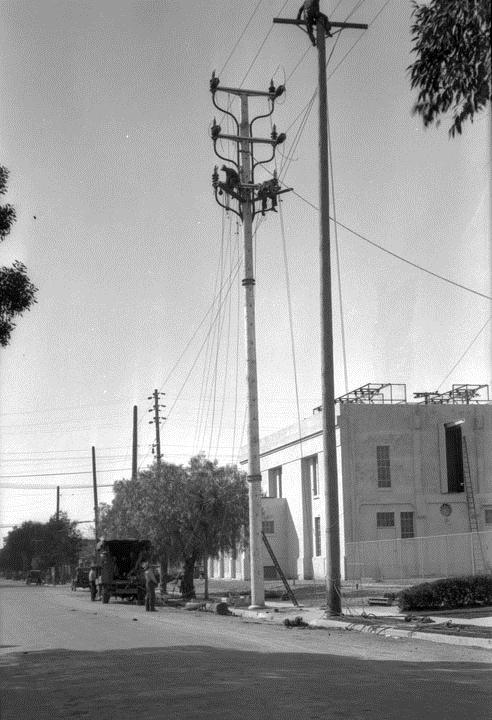 |
|
| (1930s)* - View of the first steel pole installed on Bureau of Power and Light system. It appears to be standing in front of a distribution station. |
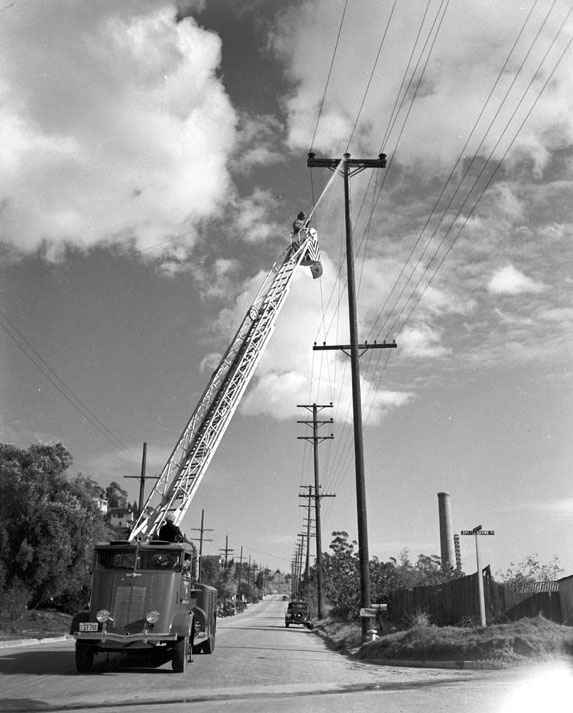 |
|
| (1939)* - The Power Bureau was putting through its paces a new insulator washing truck designed by engineers of the General Plant division. |
From the LADWP Historic Archive Outstanding feature of the new unit is a 72-ft ladder which operates through an arc of 180 degrees. At one end of the ladder is a bucket which seats the man who washes the insulators. A hydraulic hoist, controlled by an operator at the base of the ladder, raises it to any desired height within the 72-ft range. A unique safety feature is a second set of controls in the bucket which enables the employee operating the hose to cut off all operations, including movement of the ladder, at any time.Normal operating pressure of the water is 350-lb per square inch but when used on the Boulder transmission line, pressures up to a maximum of 1,000-lbs are utilized. The pumps can force 37-gallons of water per minute through the specially constructed hose from a 900 gallon capacity tank mounted on the truck chassis, making the unit a full fledged piece of fire fighting equipment also. The Moreland truck is equipped with special compound gears and special tires use in both desert and mountainous country. The entire unit was designed for silent operation since insulator washing is done at night when power lines may be taken out of service without inconveniencing Power Bureau customers. Although no performance record for the truck is available as yet, a normal month’s operation of the former unit amounted to approximately 12,000 washed insulators.** |
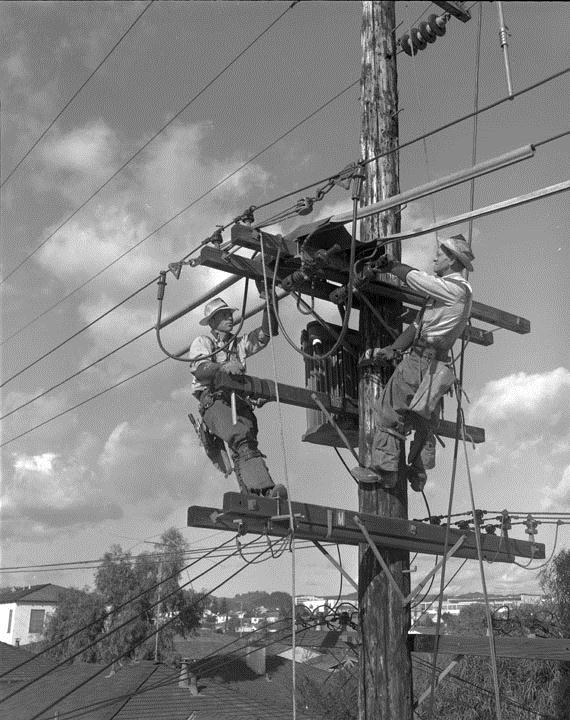 |
|
| (Early 1940s)* - Linemen at working on an energized overhead line. On the left is Oscar Williams. Note how the protective gear differs from what is used today (no hard hats). |
From the LADWP Historic Archive July 1940 – The scene is in the home of the Smiths, an average Los Angeles family. The time is after the dinner hour and Mr. Smith is reading the evening paper; his wife is doing some mending and the two children are studying their next day’s school assignments. |
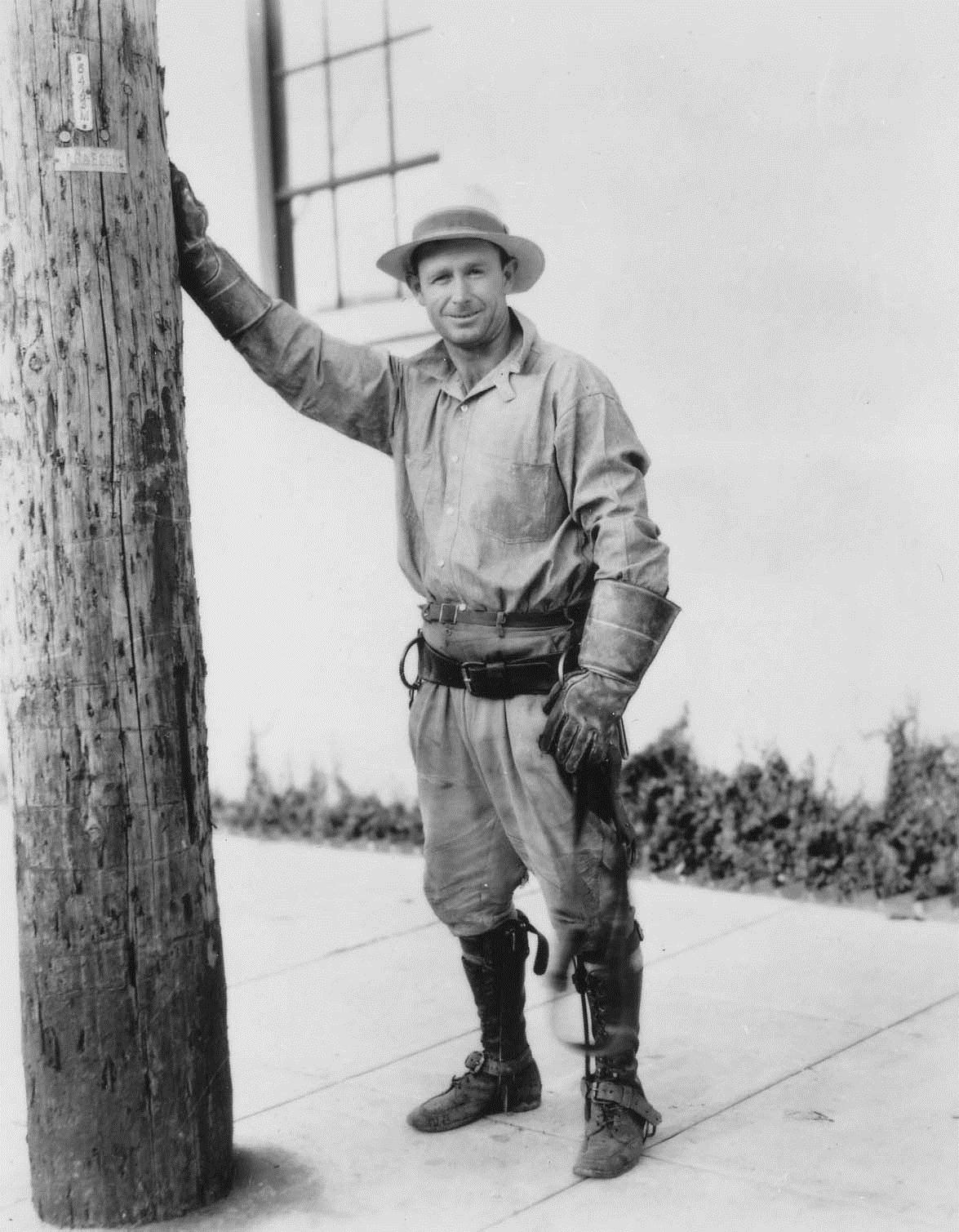 |
|
| (Early 1940s)* - Overhead Lineman, Larry Holgate (Nicknamed - 'Captain Hungry'). |
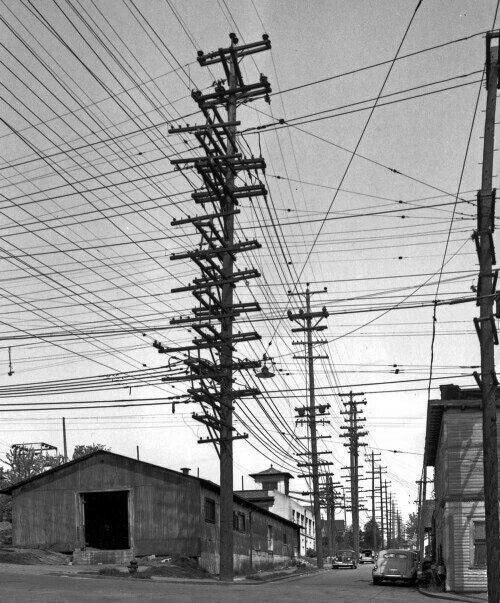 |
(1940s)## – Overhead power line congestion on an unidentifiable street in Los Angeles.
|
|
* * * * * |
Underground Construction Methods and Procedures
The use of underground electric distribution in Los Angeles began in 1897 when LA Edison Electric Co., in its first year of operations, installed a system in downtown Los Angeles. The high load density and rapidly growing demand for power in this area made an underground system a practical and economic necessity. In later years LA Gas and Electric Corp. and the Bureau of Power and Light would continue with this practice by installing their own underground system. During the 1920’s, several residential subdivisions in the western part of the City also obtained underground electric services. The developers paid the difference between cost of overhead lines and higher cost of underground installation. Because of the relatively high costs associated with underground installations as compared to overhead installations, the widespread development of underground power lines in Los Angeles did not begin until the mid-50’s. At that time, utilities began to review the former dual objective of low cost and high reliability by including a third objective – appearance. Since that time appearance has become increasingly important. |
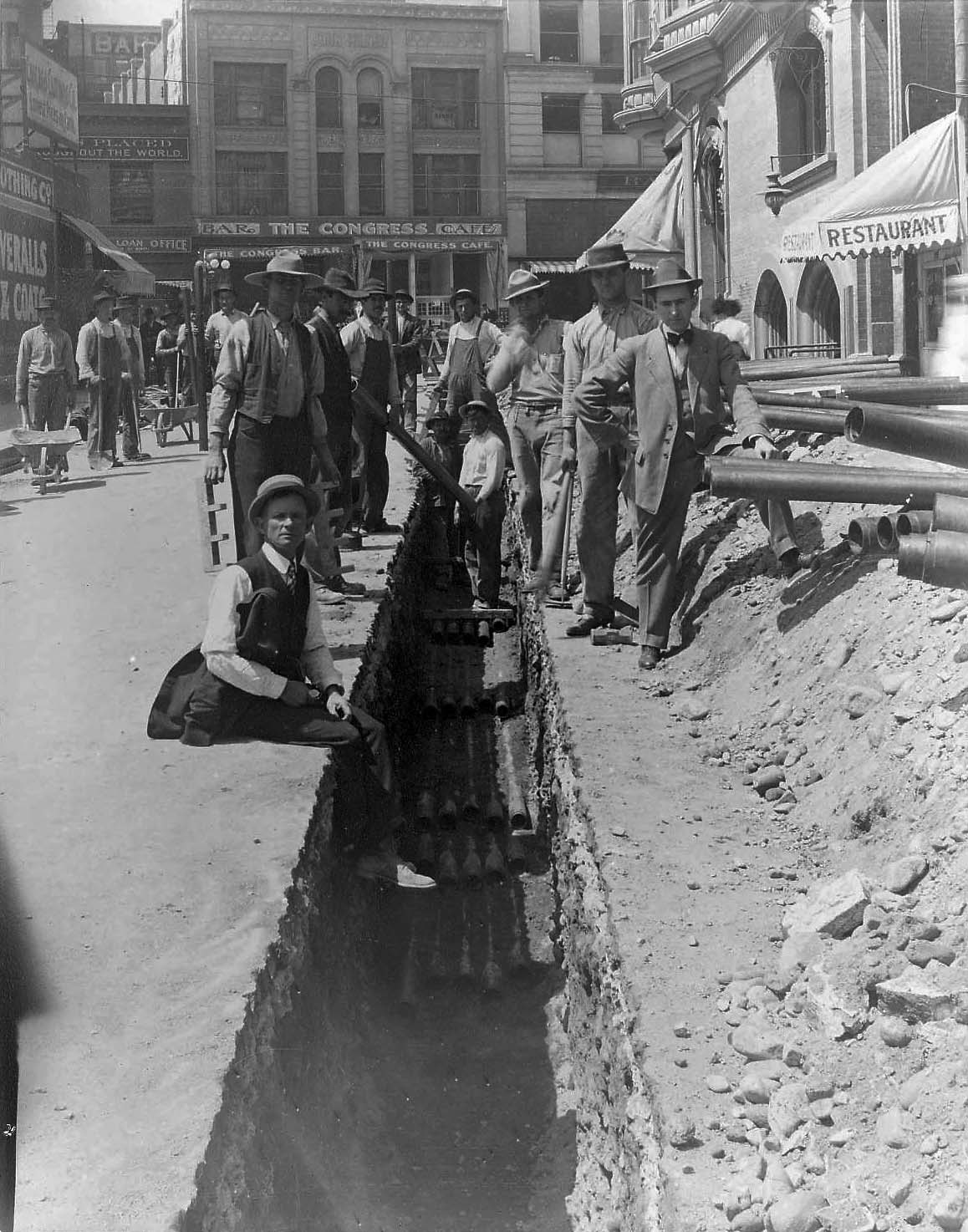 |
|
| (ca. 1897)^# – View looking northwest on Winston Street toward where it intersects with Main Street in downtown Los Angeles. An Edison Electric crew is laying conduit for one of LA’s earliest underground electric distribution systems. The building on the right with the two arched windows and a restaurant is the Main Street Savings Bank Building on the N/E corner of Main and Winston streets. |
Historical Notes In 1896, West Side Lighting Company was organized by private investors to provide another source of electricity for the city of Los Angeles and fringe areas. In 1897, West Side Lighting merged with the newly established private company, Los Angeles Edison Electric, which owned the rights to the Edison name and patents, especially the underground DC-power rights. The merged company took on the Edison name. An underground system and technology was crucial at this time, since the city voted in a resolution limiting the installation of new overhead utility poles due to excessive overhead wire congestion. Los Angeles Edison Electric installed the first major DC-power underground conduits system in the Southwest. Until the 1930's, three separate electric utilities served Los Angeles. Click HERE to see more in First Electricity in Los Angeles. |
Then and Now
 |
|
| (1897 vs. 2022) - Then and Now |
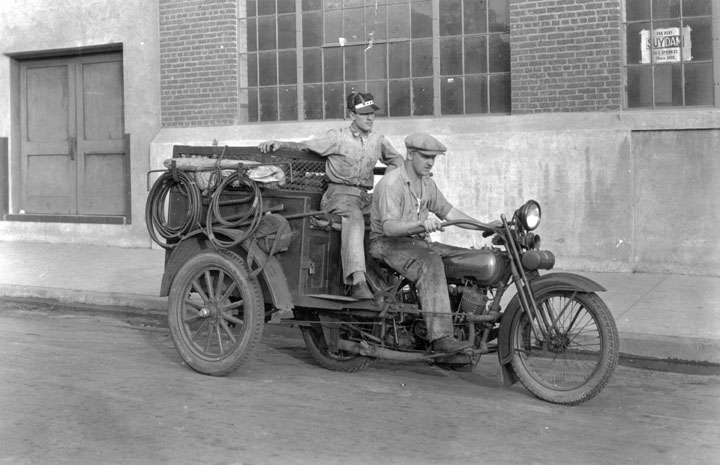 |
|
| (1920s)* - Early Bureau of Power and Light underground construction crew on a Harley Davidson trike. The driver and splicer is Elmer J. Gutsch, the helper is Carl Knobs. |
Historical Notes The name 'Department of Water and Power (DWP)' did not come about until 1937 when the City's Bureau of Water Works and Supply consolidated with the Bureau of Power and Light. Click HERE to see Name Change Chronology of DWP. |
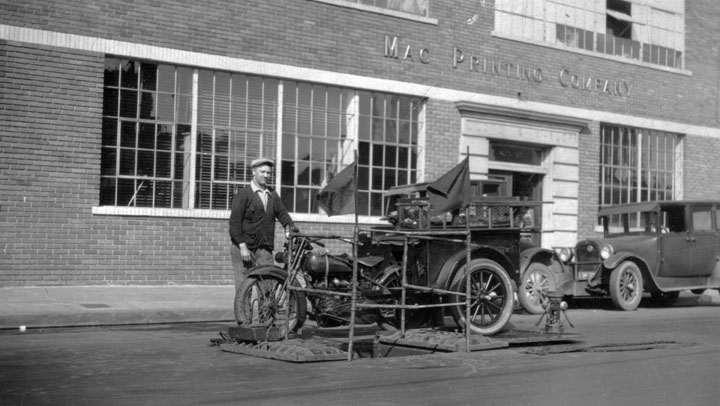 |
|
| (ca. 1920s)* - The above view shows an underground crew working in front of a printing company. It appears that the helper is standing by while the splicer is doing work inside the vault. |
 |
|
| (1920s.)* - Early Bureau of Power and Light crew posing for the camera in front of a Ford Model T truck. The man with the suit in the middle appears to be a manager and/or superintendent. |
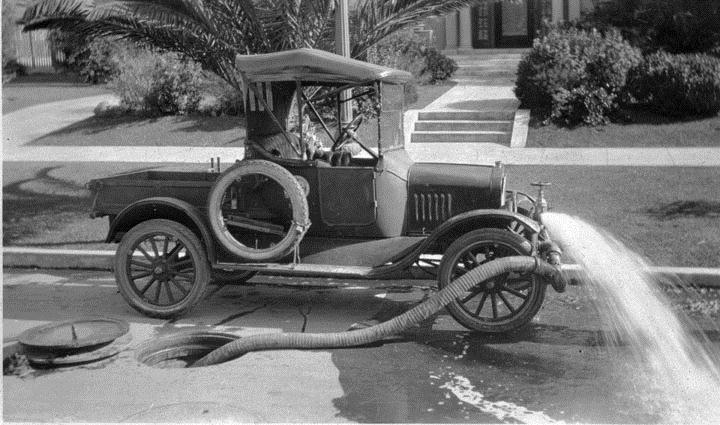 |
|
| (Early 1920s)* - Bureau of Power and Light equipment used to pump water from an underground vault (Ford Model T Truck). |
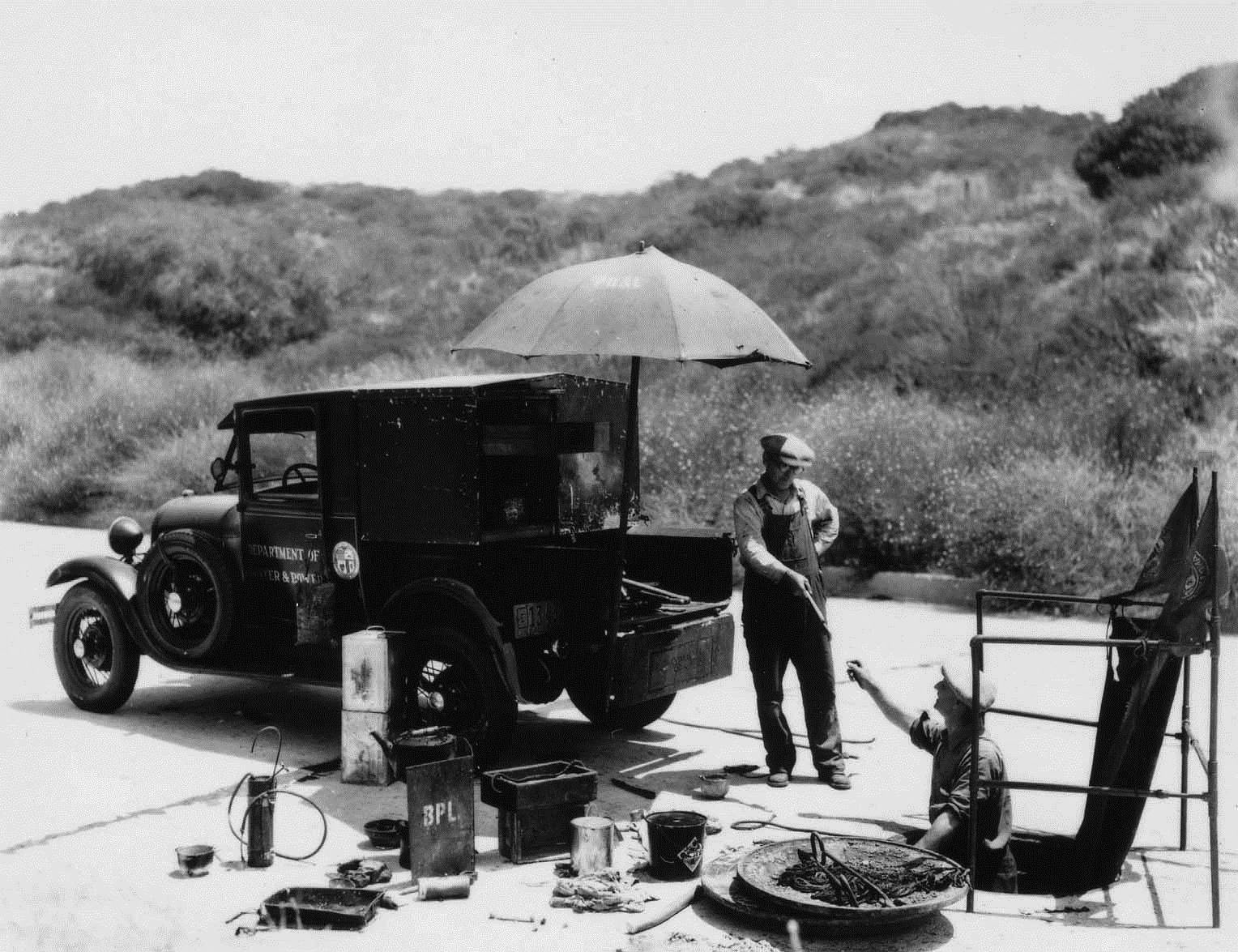 |
|
| (ca. 1929)* - Early Los Angeles Bureau of Power and Light underground construction crew working in a vault. |
Historical Notes The truck above has been identified as a 1928-29 Ford Model A. |
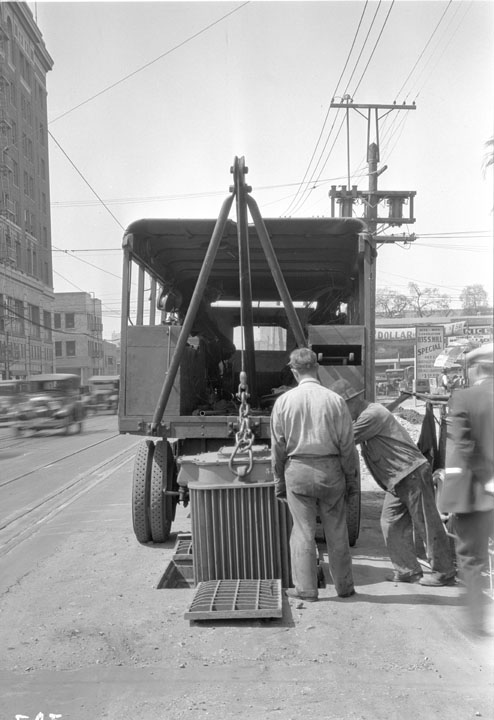 |
|
| (ca. 1920s)* - An underground construction crew is in the process of installing a transformer in a vault. |
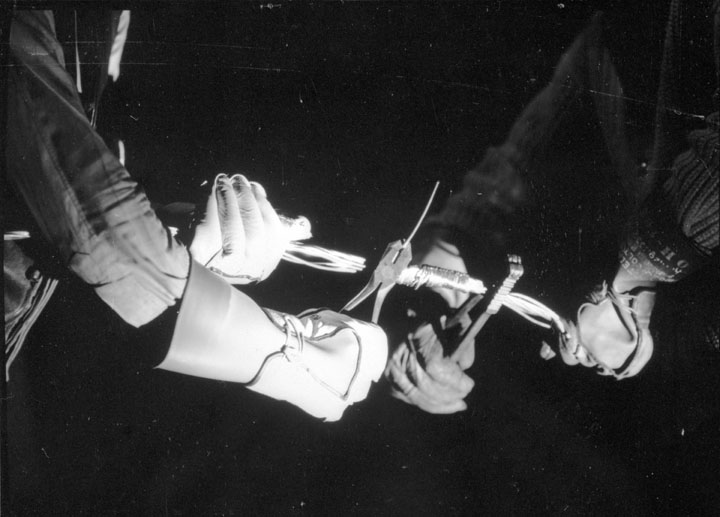 |
|
| (1932)* - View showing electrical workers wearing rubber gloves and protection while splicing 33,000 volt line wire. |
From the LADWP Historic Archive Electricity, a mystic of modern science, is like omnipotent elements, both powerful and dangerous. The electrician, whose duty it is to tame and subjugate this invisible monster, must protect himself with a weapon very unlike a sword. The value of rubber gloves as a protection against electrical shock is inestimable. Linemen and electrical workers who construct and repair high voltage lines and apparatus while they remain in operation, very often have only one-sixteenth inch thickness of rubber glove between them and the spirit side. To emphasize the necessity of un-faulty protection to the lineman from electrical shock one should witness him at work. A man perched ninety feet up on a pole with his spikes dug into keep from slipping down and a leather belt hugging him to the pole so that his arms may be free. Upon each hand he wears a rubber glove and over that a leather glove protector. After thus protecting and adjusting himself he is free to begin his task of splicing cable. From below one does not get a fair idea of how cumbersome and difficult it is to work with tools while both hands are doubly gloved and near at hand a hot wire carrying up to 4600 volts is to be constantly evaded even though one must touch it. Truly work for a brave man as well as skilled! The possibility of this danger rests solely with the lineman themselves and can only be eradicated by careful use of the gloves. Linemen are instructed carefully to inspect their gloves each time before using. Rubber gloves in some respects are like spring fruits in mid-winter. They are both perishable and expensive. Heat, sunlight, ozone and oil aid in the rapid deterioration of rubber gloves. New gloves are transported in individual cartons and are stored in a cool basement where the air is quite moist.** |
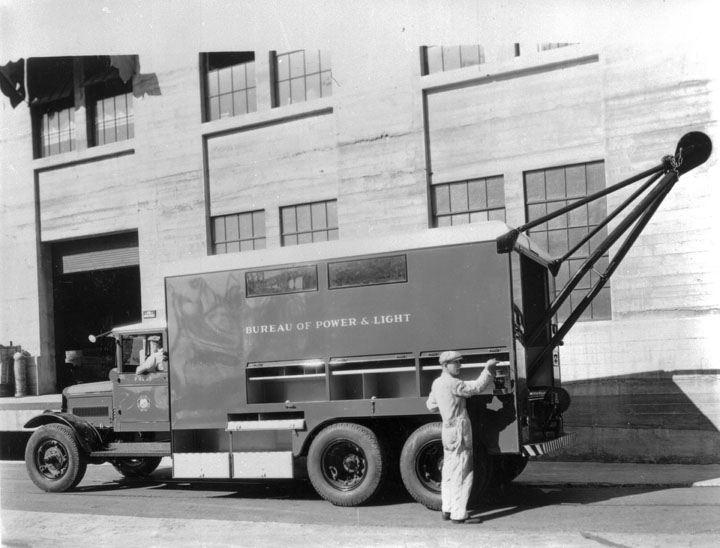 |
|
| (1936)* - 11-ton truck assigned to the Underground section of the Operating Division. It is equipped with a 10-ton winch for pulling cable through conduits. The crane is used to hoist transformers from manholes. This truck was designed by the Engineering section of the General Plant division and fabricated in the machine shop at 1630 N. Main. Click HERE to see Early Views of the Machine Shop. |
Historical Notes The truck above is a Moreland 11 ton truck with 10 ton winch. |
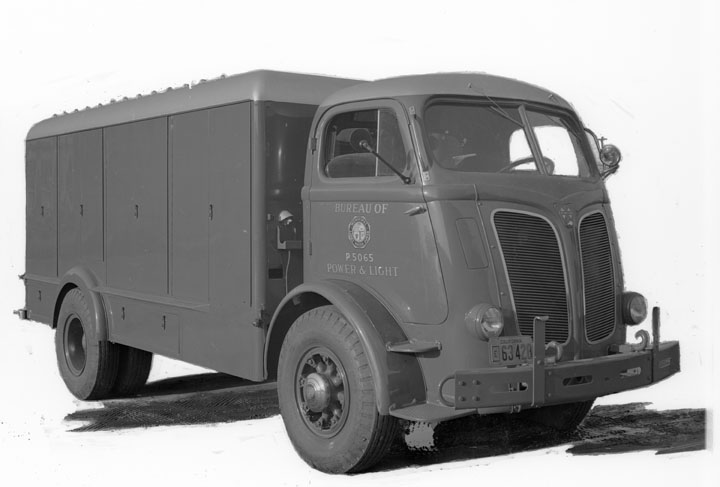 |
|
| (1941)* - View showing front and side of new underground service truck (Moreland D-500 or DR-700). |
* * * * * |
Early Metering Equipment
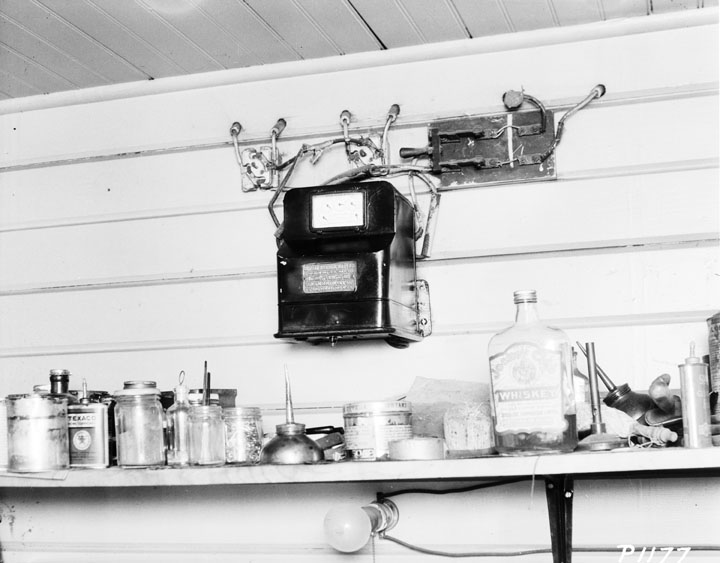 |
|
| (1934)* - The old indoor type of meter installation, with open service wiring and a typical back porch shelf collection is shown. |
From the LADWP Historic Archive
May 15, 1934 - In the past the electric meter has usually been relegated to the dim and inaccessible recesses of the consumer’s premises. Its social standing was honest but prosaic. When reading, tests or changes had to be made and the customer’s premises were found locked, meter men frequently called back repeatedly before gaining entrance. Inadequate protection for wiring and meters made theft of current a serious problem. All of these items represented lost hours, labor and money.
But now, like a modern Cinderella dressed in new raiment, the electric meter has said farewell to its former companions of the back porch and closet and has taken its place outside in a new environment, according to information from L. H. Ellerman, assistant superintendent of Testing Laboratories.
The drafting of a new electrical wiring ordinance for the City of Los Angeles furnished the opportunity to adopt the so-called “new sequence’ (meter—switch—fuse) of service connections. This innovation in distribution practice permits the meters to be set either indoors or outdoors ahead of the customary fuse protection.
Appreciating the importance of standardization insofar as it affects consumers, electrical contractors, utilities, and others, the Bureau invited the active co-operation of other utilities in sponsoring a unified code of service requirements. A “Utilities Code Committee” was formed with representatives from other local utilities to present recommendations to the Department of Building and Safety for inclusion in the new Los Angeles Electrical Ordinance. Mr. Ellerman was chosen as the Bureau’s representative to serve on this committee.
Among a number of other changes called for in this code, which became effective May 1, 1934, meters in new dwellings are to be set in a recessed compartment built into the outside wall. Also, for all classes of power and light installations, service wires up to and including the meter will be metal-clad, thus serving as a great deterrent to the tampering evil. Meter manufacturers have aided the local program by producing recently a new type of armored and weatherproof meter. The net result is that the new methods of installation and new type meters will solve many metering problems.
Here are some of the advantages to be derived from the new unified metering arrangement: (1) Better public relations; meter men need not disturb consumers, as facilities are provided for testing without interruption and for cutting off and turning on service. (2) Unified methods of electrical connections for local utilities mean less confusion for the electrical contractor and others, saving time and money. (3) Protection against theft of current. (4) Meters can be easily read, tested, installed or removed, saving time of meter men and eliminating return calls. (5) Existing meters can be easily adapted to the scheme.**
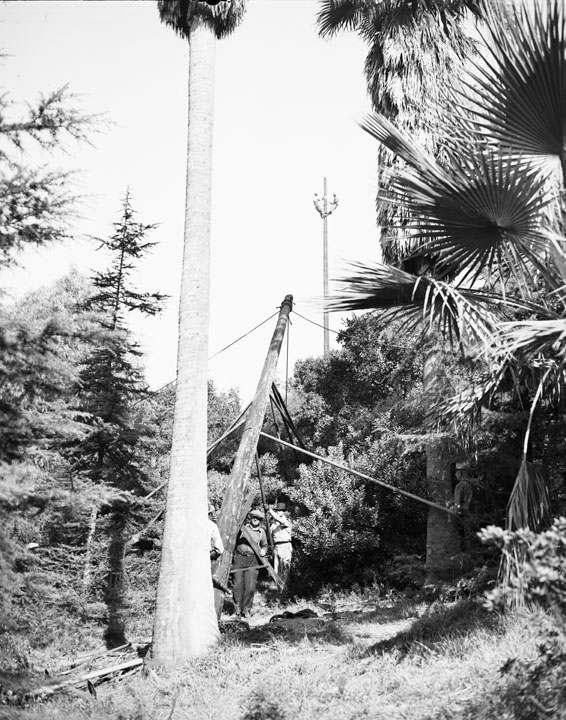 |
|
| (1937)* - Temporary transmission line being erected around slide area in Elysian Park. In the distance, two men can be seen near pole top. |
* * * * * |
Early Distribution Construction Yards
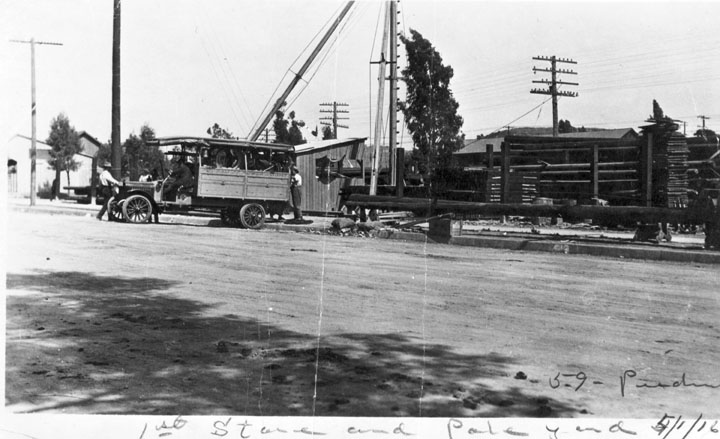 |
|
| (1916)* - First warehouse and pole yard. |
.jpg) |
|
| (ca. 1926)* - Exterior view of Van Nuys Overhead District No. 5 located at 6800 Van Nuys Boulevard, on the northeast corner of Van Nuys Boulevard and Oxnard Street. Sign on building reads: WATER - POWER - LIGHT. Click HERE to see the chronology of name changes for DWP since 1902. |
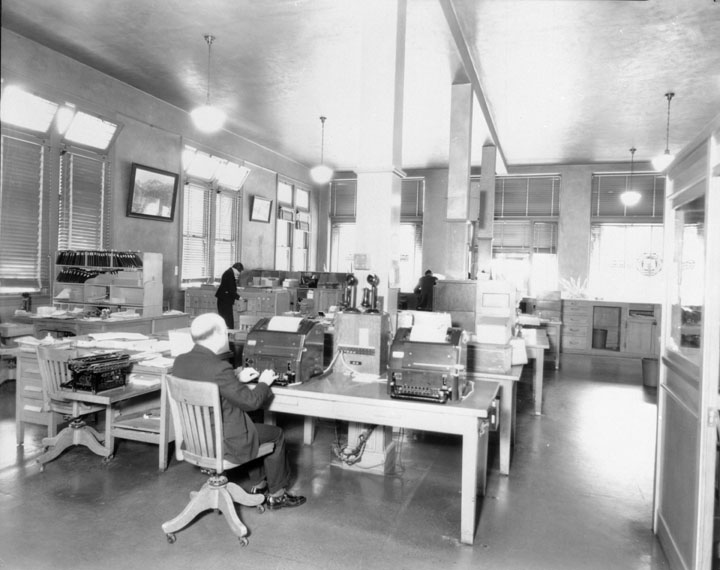 |
|
| (n.d.)* - Interior view of the Van Nuys Overhead Distribution Headquarters office at 6800 Van Nuys Boulevard. |
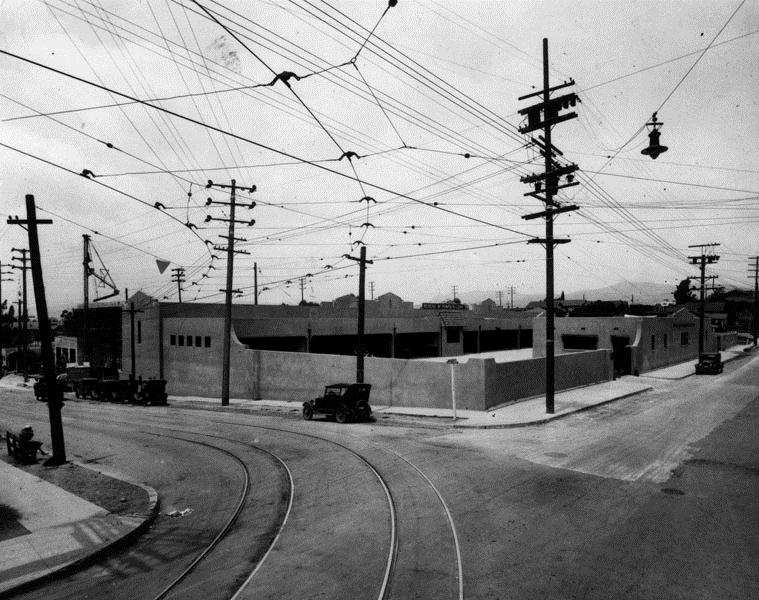 |
|
| (1927)* - Early Overhead Distribution Yard (District No. 2). Today, it is the Streetlight Maintenance Yard. |
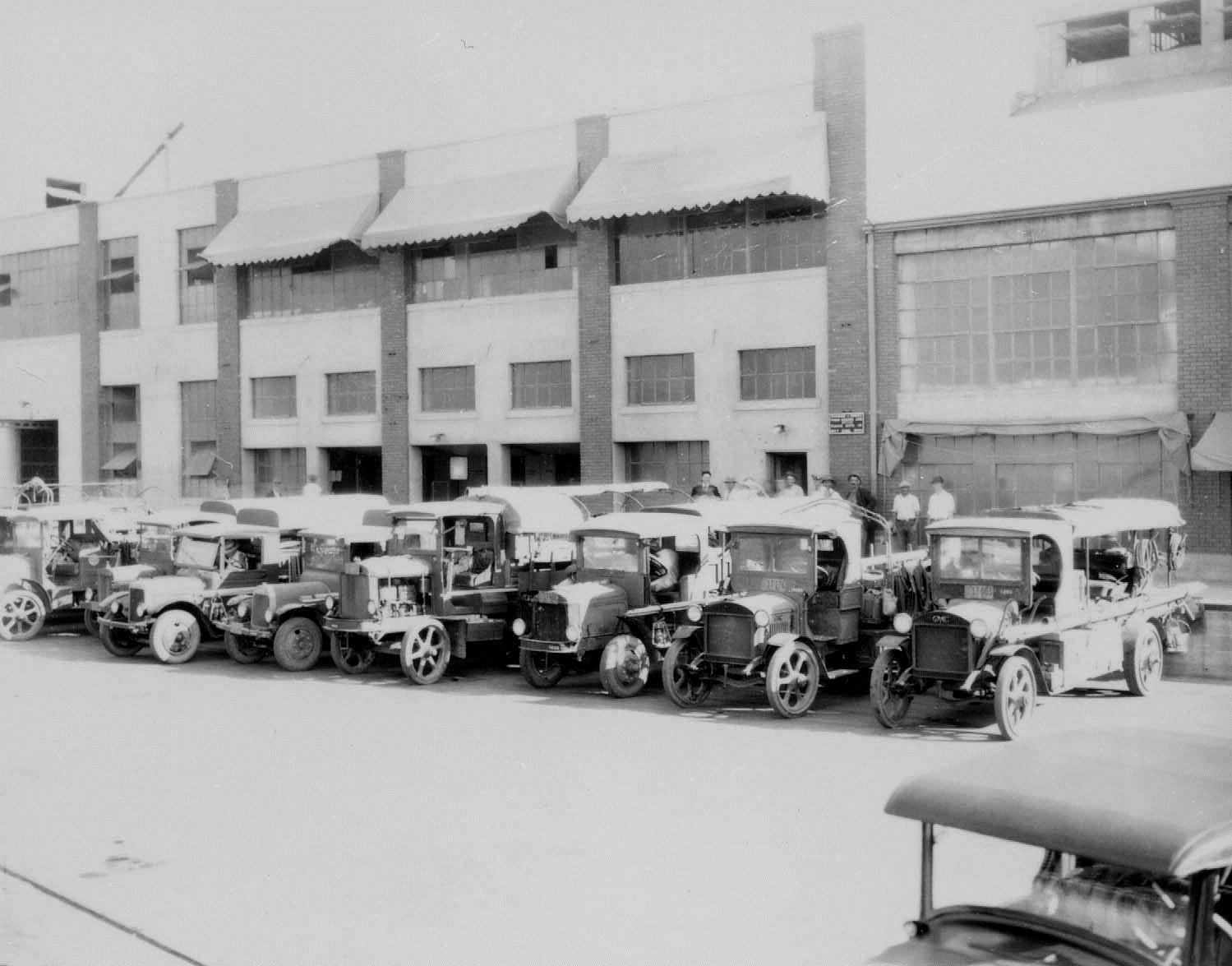 |
|
| (1930)* - Power trucks at the Ducommun Street yard. Click HERE to see more Early Views of the Ducommun Yard. |
* * * * * |
Bureau of Power and Light Streetlights
 |
|
| (Early 1920s)* - Bureau of Power and Light crew working on an ornamental street light. |
LADWP Historical Archive (1973) Despite the variety of designs, street lights are known as either electrolier or utilitarian types, according to Harvard Johnson, engineer in charge of Street Light Design. Customers own the electroliers --- lamps affixed to concrete or metal posts. The customer-owners of these are most likely the Department of Public Works or residents who form a private street lighting district. |
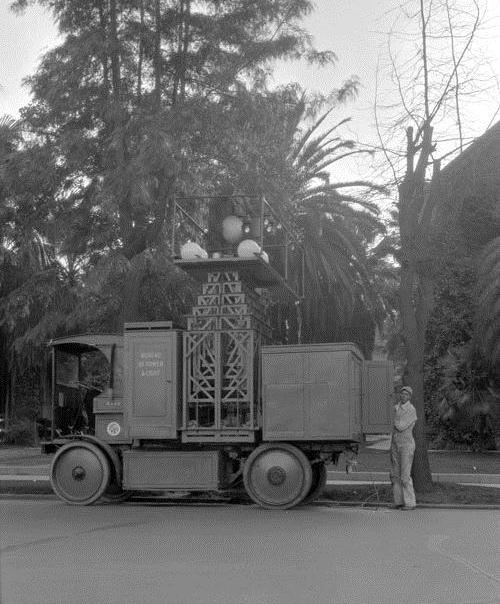 |
|
| (Early 1920s)* - An electric powered street light truck used by the Bureau of Power and Light in the 1920s. |
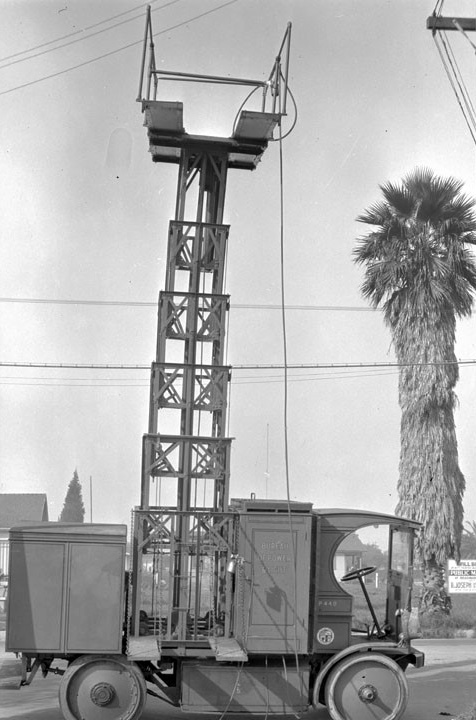 |
(Early 1920s)* - Electric-powered street light truck with platform fully extended.
|
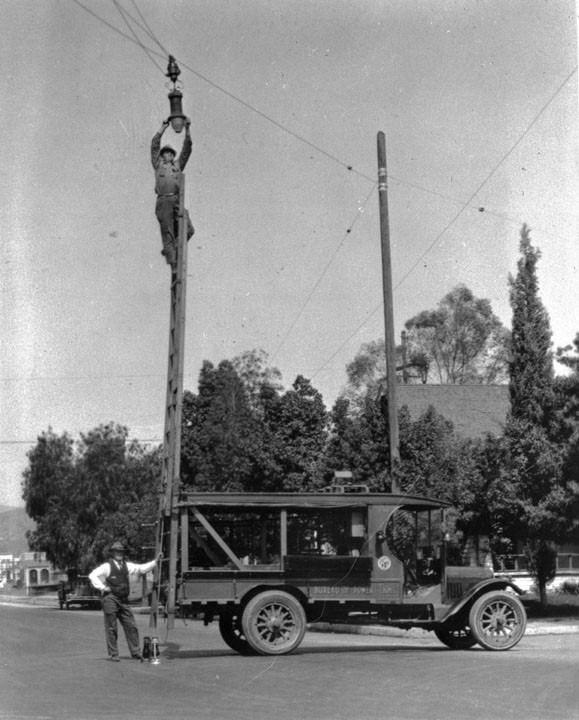 |
|
| (Early 1920s)* - Bureau of Power and Light worker changing out a hanging lamp in the middle of an intersection. |
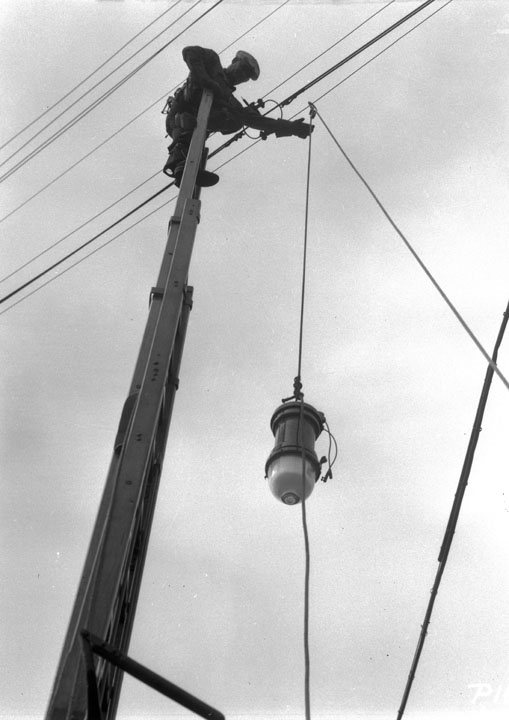 |
(Early 1930s)* - New street light being pulled up for installation.
|
|
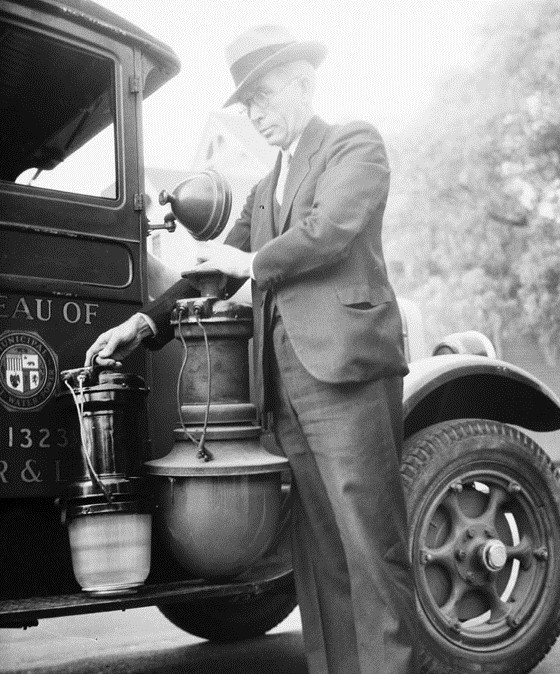 |
(1933)* - L. G. Gould with a new and an old incandescent lamp at 30th and Trinity Streets.
|
|
Historical Notes This marked the close of another era in the development of Los Angeles. The last arc light in the City was removed November, 1933 by L. G. Gould's street lighting section and replaced with a modern incandescent lamp.* |
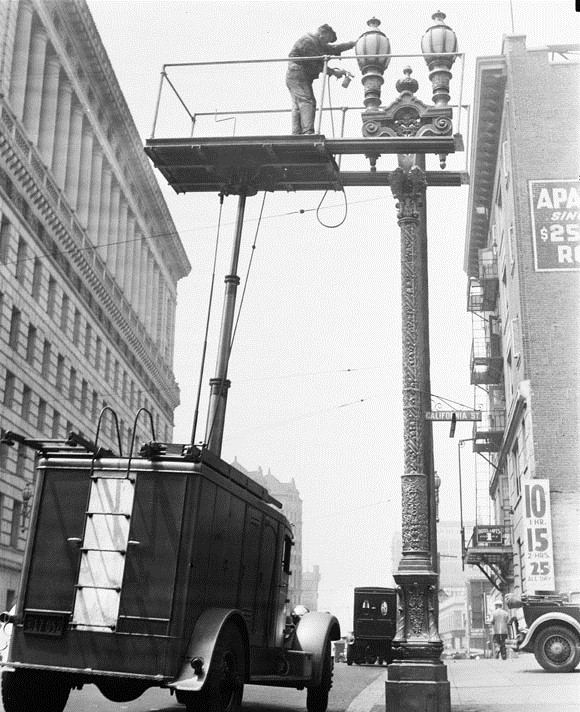 |
|
| (1935)* – Greatly facilitating the maintenance work on street light standards, a new five-ton tower truck was placed in service June 6th by the Power Bureau’s Street Lighting section. The first painting job assigned to the truck’s crew was two-light standards on Broadway between California and Pico Streets. |
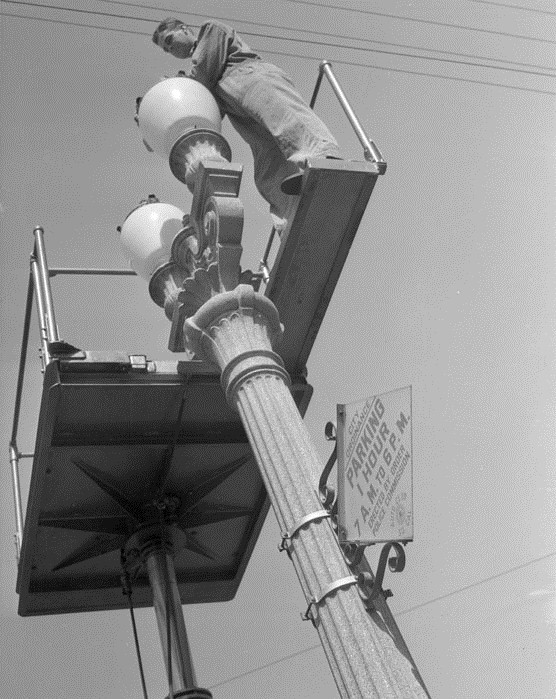 |
|
| (ca. 1940)* - Early DWP Streetlight Maintenance worker repairs an electrolier. |
.jpg) |
|
| (ca. 1940s)* - Early streetlight adjacent to the Municipal Water and Power office building in downtown Los Angeles. |
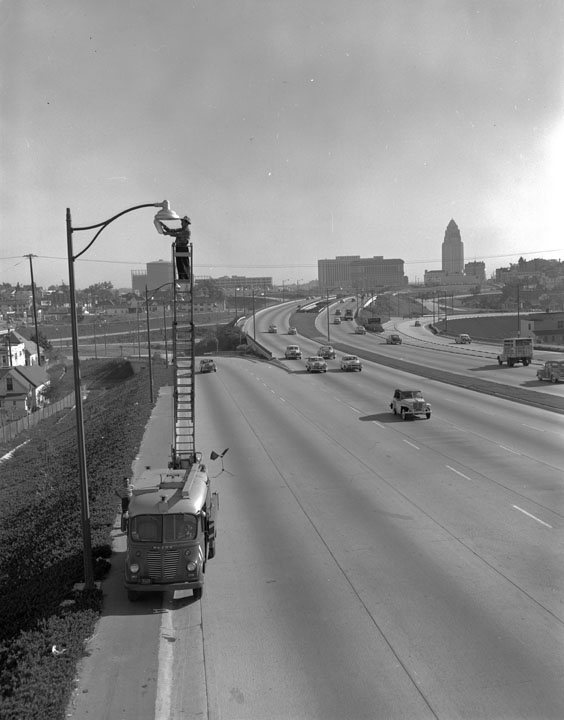 |
|
| (1952)* - Street lighting maintenance unit on the Hollywood Freeway. Caption reads: Modern-day lamplighter seen against Los Angeles' downtown skyline is James Salazar of the Street Light Maintenance section. These lights on the Hollywood Freeway don't have to be lit by hand, of course, but they do require washing and globe replacement. On ground is Joe J. Restivo. Truck with electrically operated ladder is one of four used by the Street Light section. |
 |
|
| (ca. 1960s)* - DWP Streetlight Maintenance Crew changing out a lamp. |
* * * * * |
Meter Reading
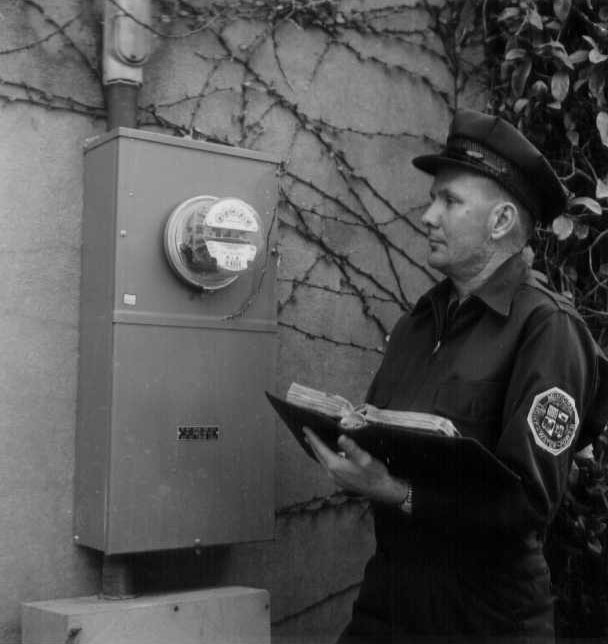 |
|
| (1963)*# - View showing a DWP Meter Reader before hand-held computers. |
* * * * * |
Contemporary Power Distribution Views
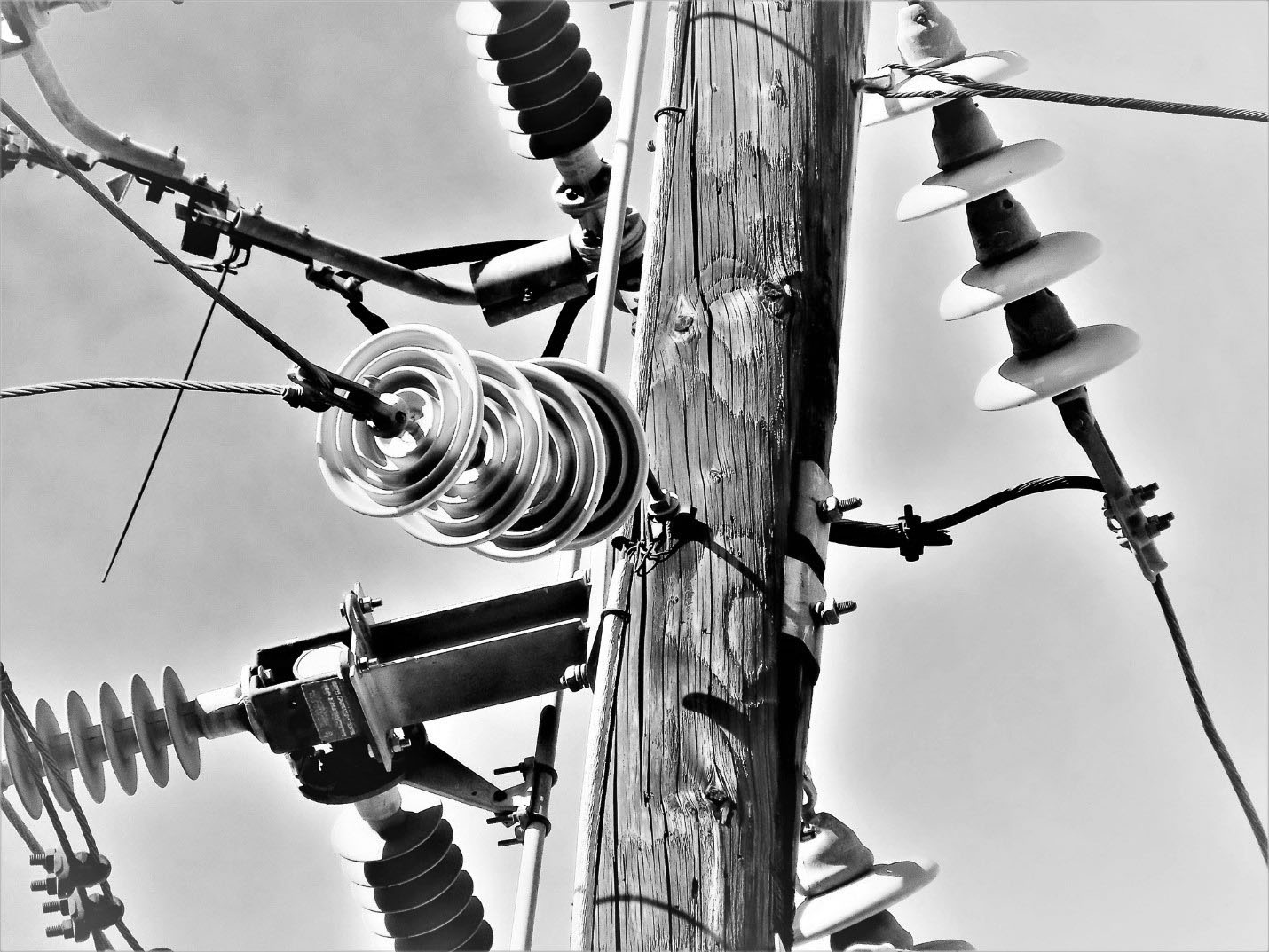 |
|
| (2021)* – 34.5KV insulators and switches on an old DWP pole. Sometimes things get get cluttered. Photo by Howard Gray |
Historical Notes This photo shows part of LADWP’s medium-voltage infrastructure operating at 34.5 kV, typically used for distribution feeders and trunk lines. The presence of cluttered hardware is indicative of legacy poles that have undergone multiple upgrades without complete replacement—common in older parts of the overhead system. Overhead construction like this still dominates, despite aesthetic and reliability challenges. |
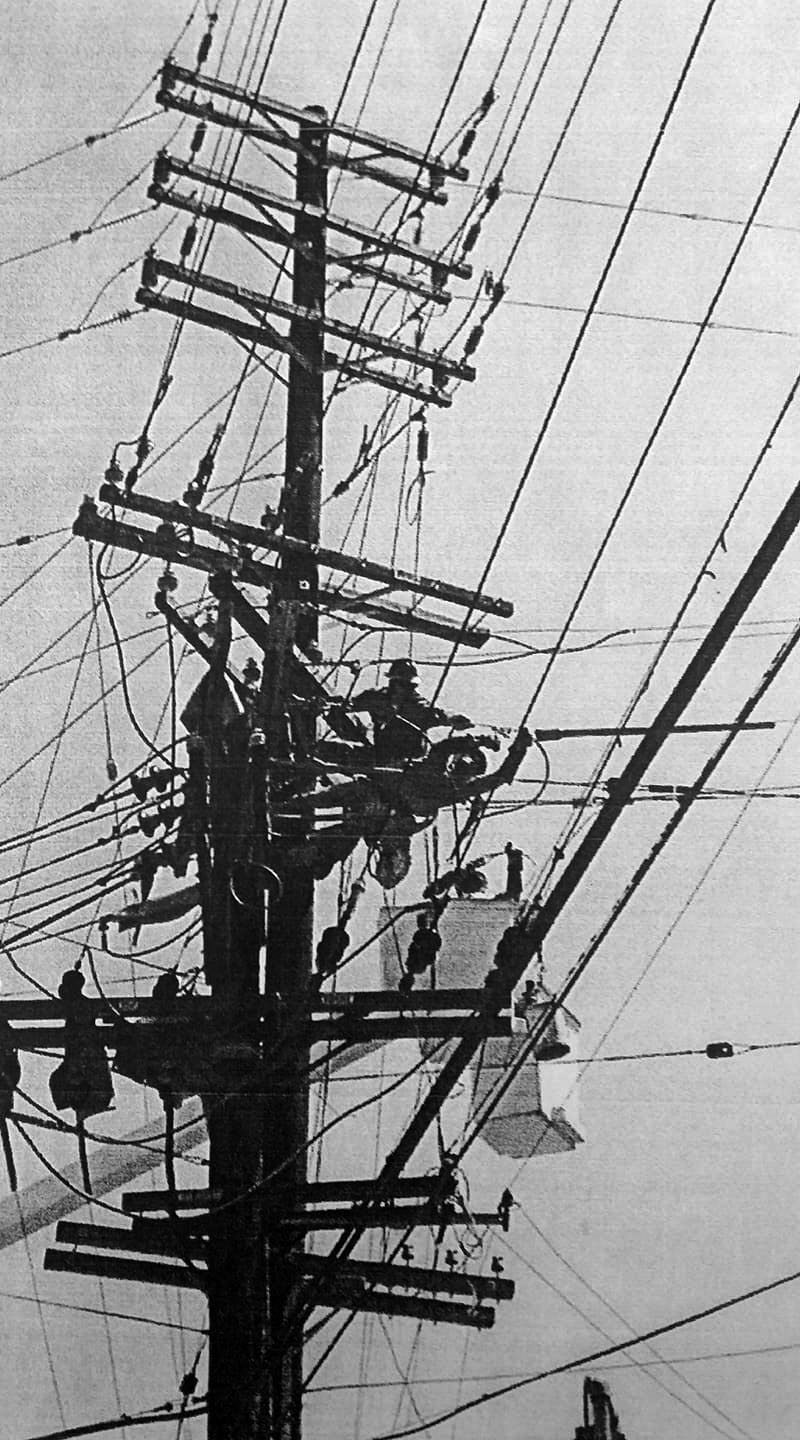 |
|
| (ca. 2020)* - Routine line work - LADWP linemen in action on a busy pole. Pole location is at the intersection of N. Pacific Avene and N. Front Street in San Pedro |
Historical Notes Line crews perform daily maintenance and emergency response on 4.8 kV primary circuits, the backbone of LADWP’s overhead system. Work is often conducted from bucket trucks, highlighting modernization since the 1940s. This image reflects the continued reliance on above-ground distribution, which makes such repairs faster and more cost-effective than underground systems. |
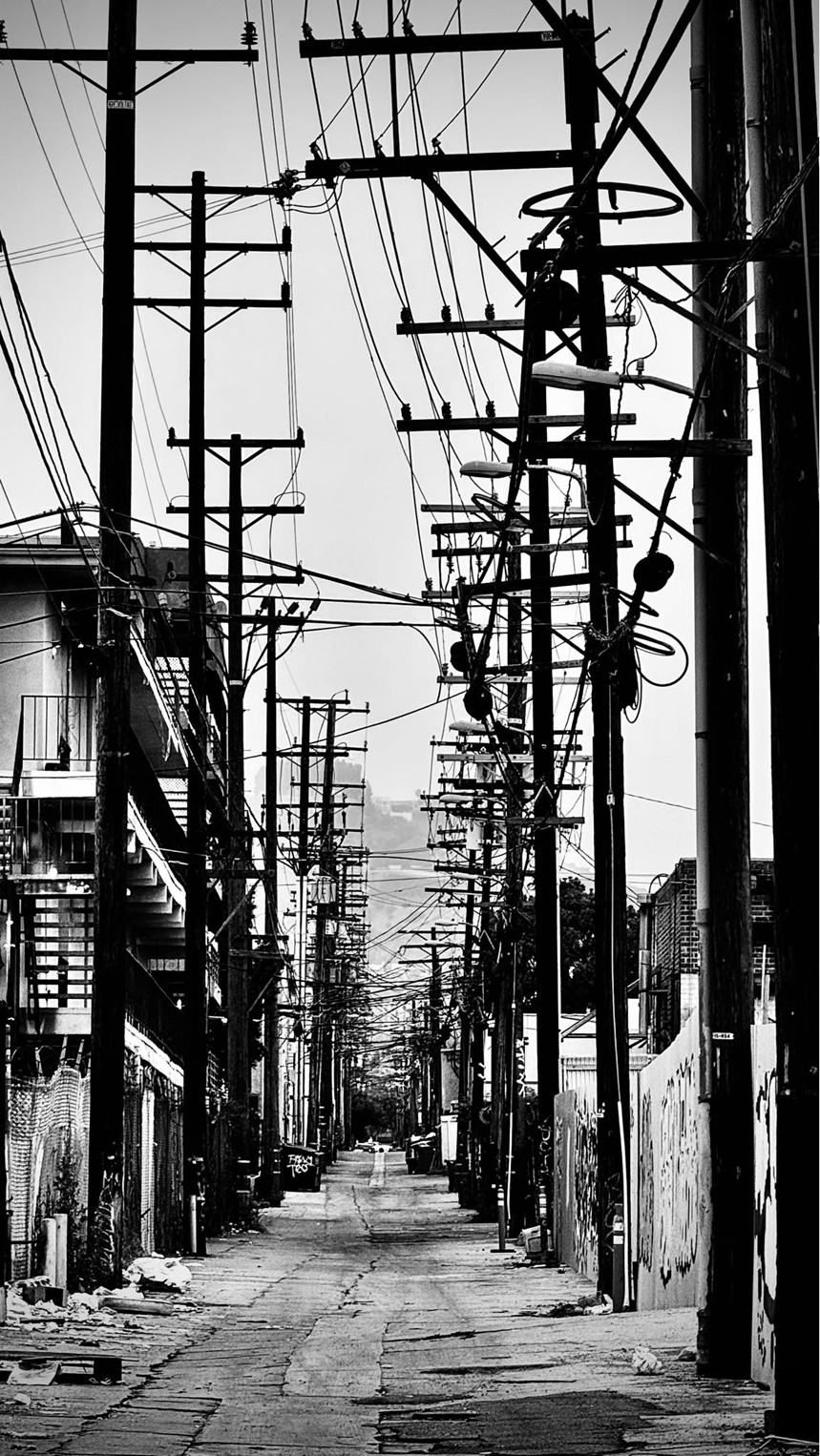 |
|
| (2025)* - Looking north up the alley from 7915 Beverly Boulevard, just west of Fairfax Avenue, with the Hollywood Hills faintly silhouetted in the distance. Photo by Carlos G. Lucero. |
Historical Notes A dense alley view typifies LADWP’s network of 800+ miles of alley-distributed overhead lines, supported by an estimated 180,000+ utility poles across the city. Poles often carry a mix of power and communication lines. The alley serves as a visual microcosm of the scale and complexity of Los Angeles' older infrastructure. |
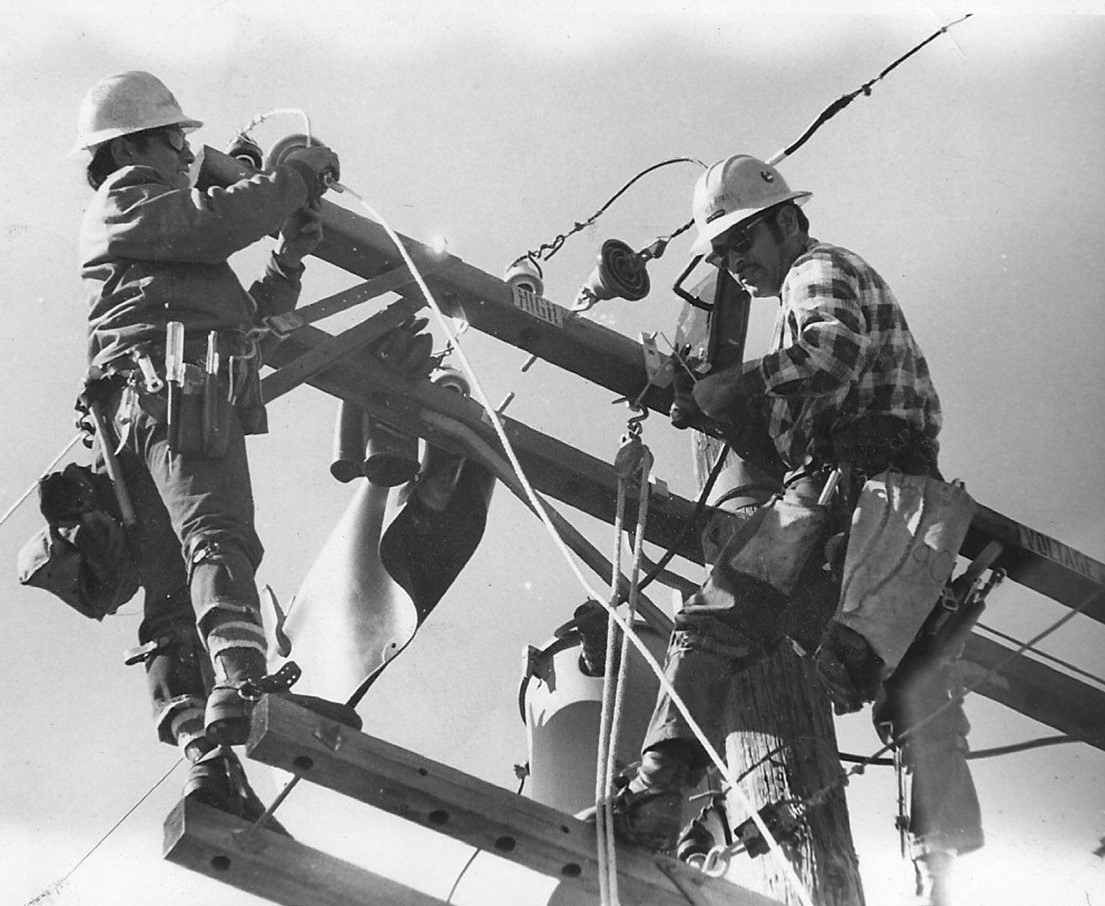 |
|
| (ca. 1980's)* - DWP lineman Ted Dario (left) working on an energized 4.8 kv primary circuit. Ted was known not only for his excellent work but also for his dedication to the Lineman’s Rodeo. Photo courtesy of his son, Mike Dario. |
Historical Notes This image captures a lineman working “hot” on a 4.8 kV primary line, LADWP’s standard voltage for neighborhood distribution. Such energized work requires advanced skill and is often done to avoid service interruptions. Ted Dario’s participation in the Lineman’s Rodeo also reflects the profession’s culture of excellence and camaraderie. |
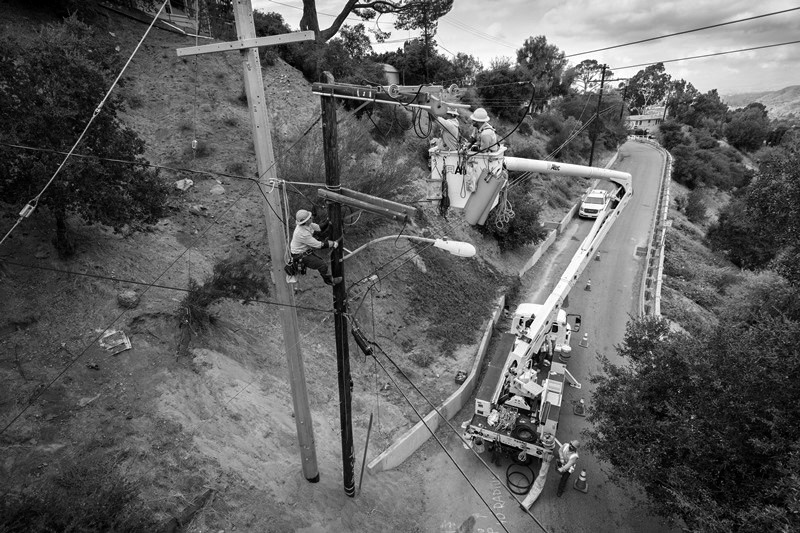 |
|
| (2019)* - A Van Nuys District DWP crew works to replace a fallen wood pole with a steel pole in Tujunga–an extreme fire risk zone. |
Historical Notes Ken Boothe, Supervisor of Transmission and Distribution out of the Van Nuys District, was overseeing the replacement of two wooden poles on Tujunga Canyon Boulevard that were damaged by a falling tree during a wind storm. Because of the location in a Tier 3 extreme fire risk zone, Power Distribution opted to replace the wooden poles with steel poles. Situated close to homes, up against a hillside, the poles were supporting two spans of 4.8 kV wires along with communication lines. |
 |
|
| (2019)^ - DWP crews work to restore power after outages. |
Historical Notes Restoration work is a routine part of overhead system maintenance, which, while more vulnerable to weather than underground, allows faster response and simpler rerouting during outages. Crews are trained to address faults on 4.8 kV and 34.5 kV lines, balancing speed with safety. |
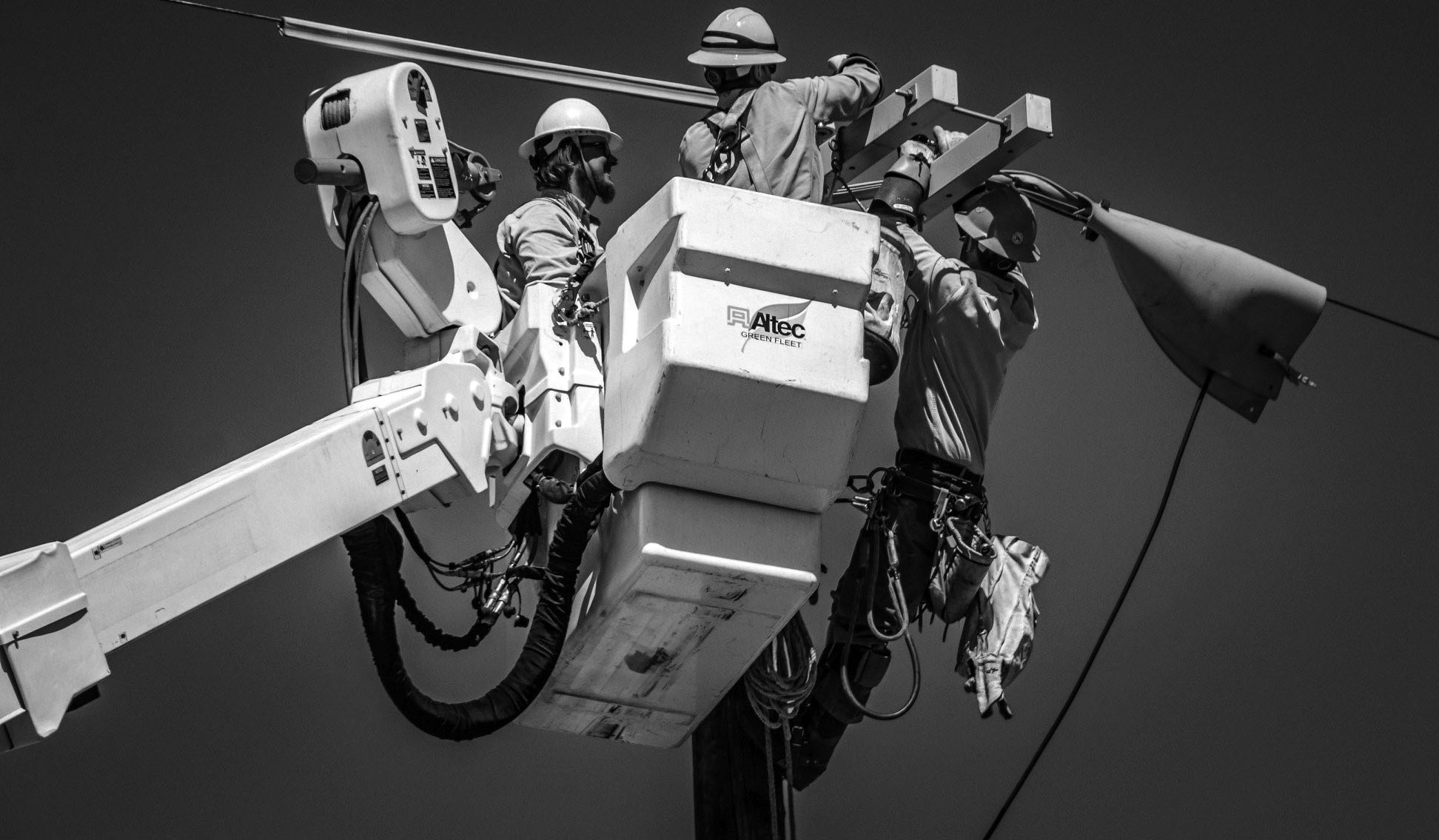 |
|
| (2019)* – A DWP crew changing out cross arms with energized 4.8 kV wires around them. |
Historical Notes Crossarm replacement is standard in preventive maintenance or following storm damage. The continued use of wooden crossarms, often swapped for composite or fiberglass ones, shows the balance LADWP maintains between modernization and cost-efficiency. The energized environment again demonstrates LADWP’s field proficiency. |
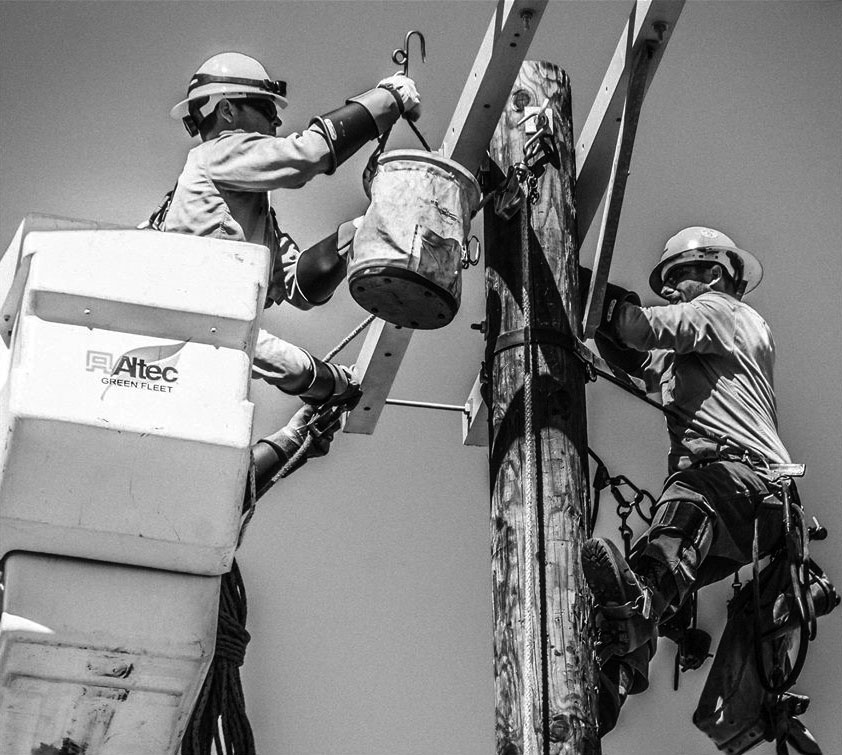 |
|
| (2019)* - Close-up view showing 3 linemen changing out a cross arm. Two are in buckets and a third is strapped to the pole. |
Historical Notes The teamwork of linemen in a live environment underscores the complexity of overhead line work. A mix of bucket truck and pole climbing techniques reflects evolving safety practices since earlier decades. |
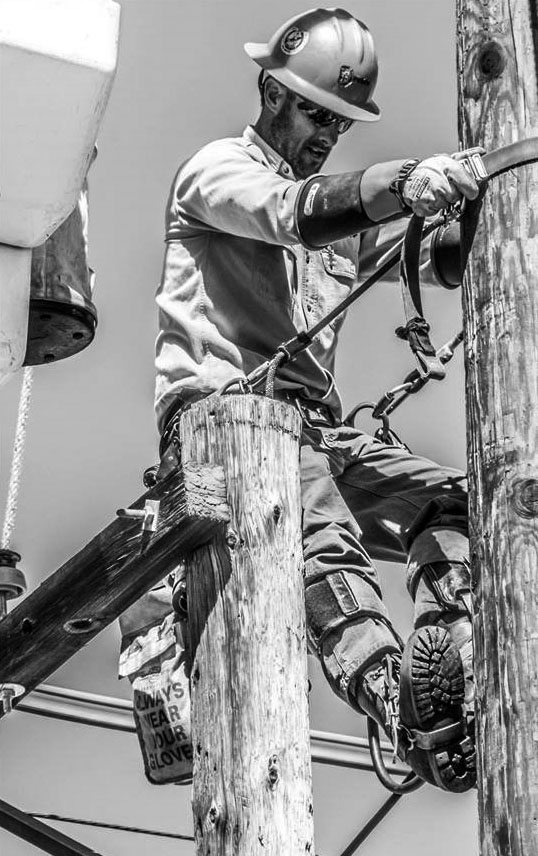 |
|
| (2019)* - HARD DAYS WORK! Writing on bag at lower left reads: ‘ALWAYS WEAR YOUR GLOVES’ |
Historical Notes This small detail highlights the culture of safety within LADWP line crews. The organization has continually updated personal protective equipment (PPE) and training standards, especially since the 1980s, as part of its broader Power Reliability and Worker Safety programs. |
Then and Now
 |
|
 |
|
| (1940s vs. 2019) |
Historical Notes Notable differences include:
|
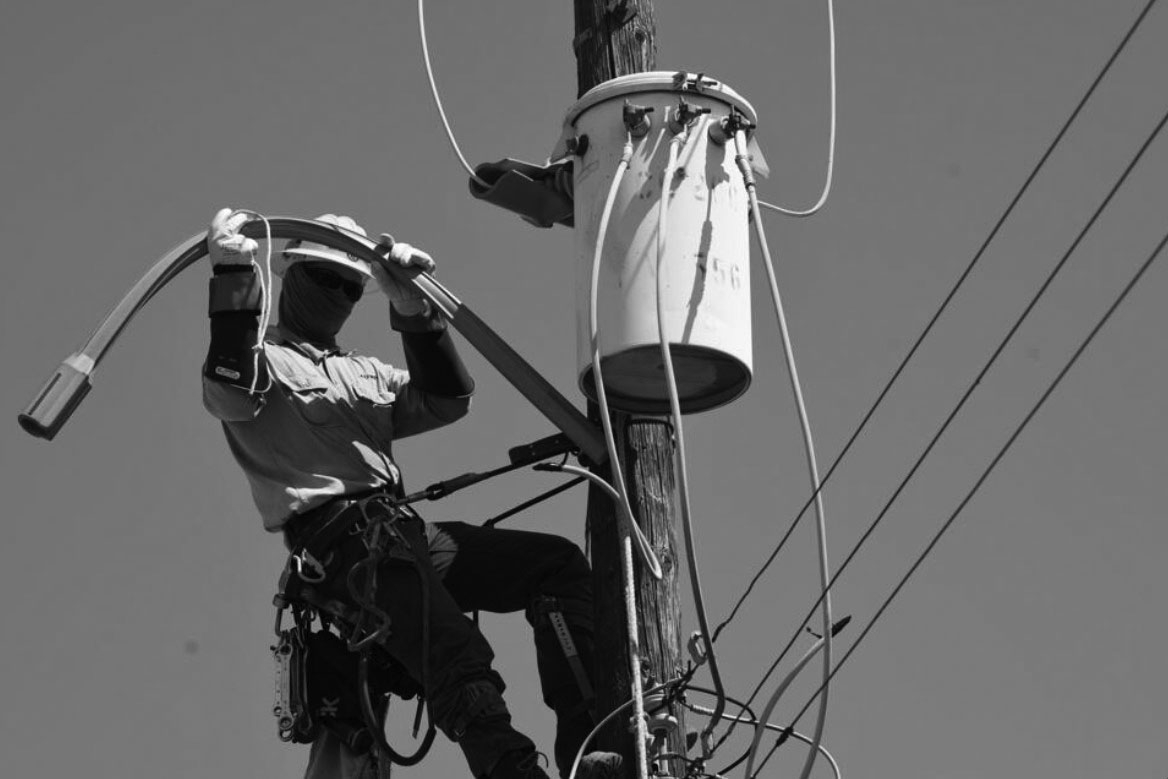 |
|
| (2020)* – DWP lineman working to restore power after a heat storm outage. |
Historical Notes Extreme weather, especially heat events, now causes more frequent outages in the aging 4.8 kV system. Crews are often dispatched rapidly to restore circuits strained by high load and thermal stress. |
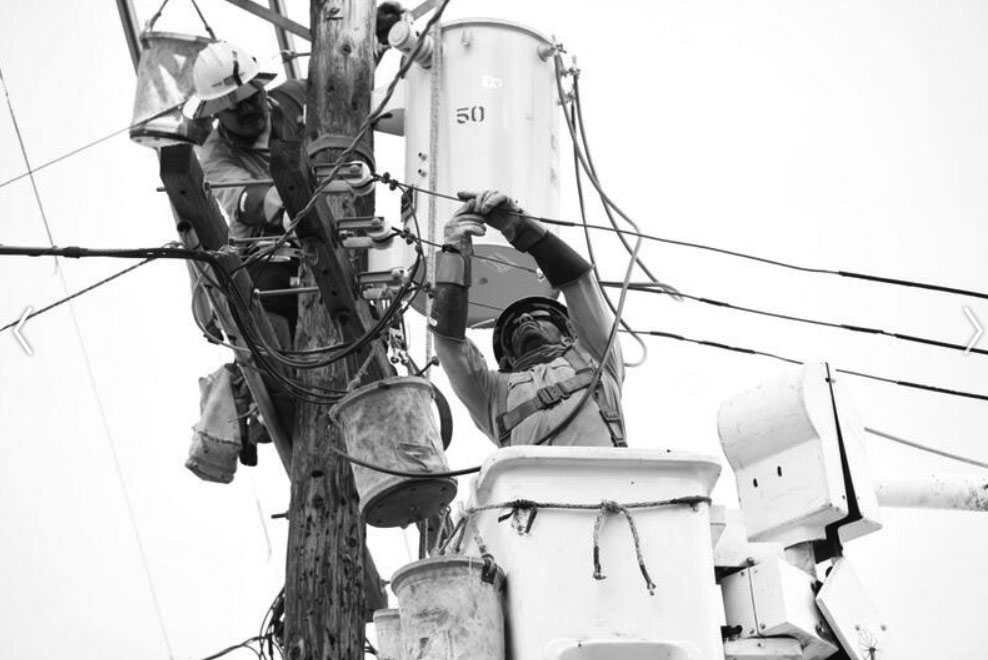 |
|
| (2020)* – DWP crew reconnecting to secondary after a transformer changeout. |
Historical Notes Transformer replacement is a key aspect of overhead maintenance. Many LADWP transformers are decades old, and newer models are being phased in to improve efficiency and reliability—especially near dense load centers. |
 |
|
| (2020s)* - An aerial ballet off the westbound 10, linemen in elegant motion against the backdrop of the dirty old town. It looks like their changing out a pole. |
Historical Notes This poetic capture celebrates the skill of LADWP linemen performing complex overhead tasks. Pole changeouts on high-traffic corridors often involve coordination with transportation agencies and sometimes helicopter-assisted work in extreme cases. |
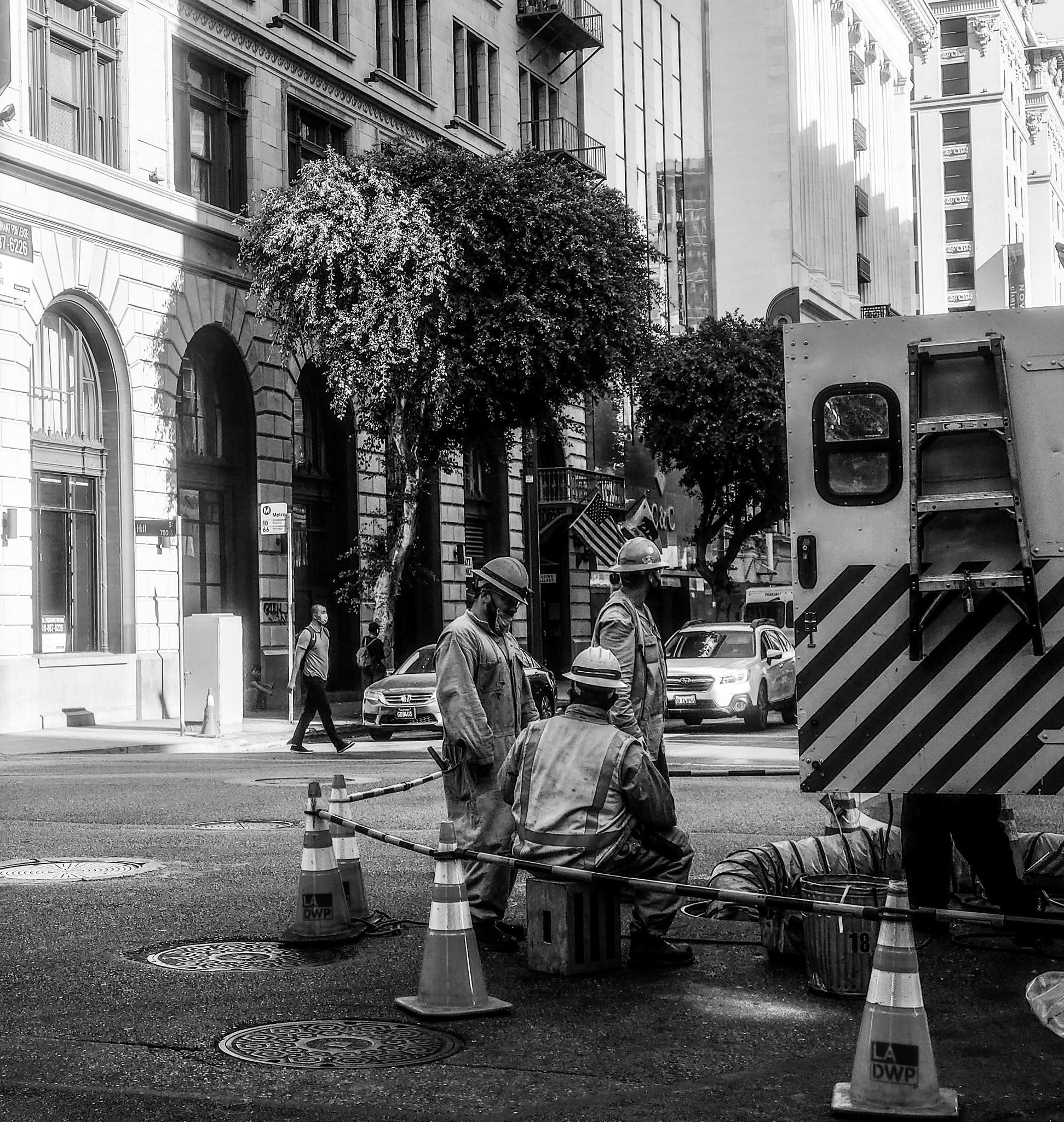 |
|
| (2020)* – DWP underground crew in Downtown Los Angeles. Photo by Gary Christian |
Historical Notes Downtown Los Angeles features more undergrounding—part of the 30% of the system not visible from the street. Crews here handle high-voltage feeders and secondary networks in subsurface vaults, often in more challenging and constrained environments than overhead work. |
* * * * * |
History of Water and Electricity in Los Angeles
More Historical Early Views
Newest Additions
Early LA Buildings and City Views
* * * * * |
References and Credits
* DWP - LA Public Library Image Archive
*^LA Public Library Image Archive
^^Metro Transportation Library and Archive
*#DWP - Water and Power Associates Historical Archives
^#Huntington Digital Library Archive
##Pinterest.com: OH Line Congestion
^x^Facebook.com: So. Calif. Historic Arrchitecture
< Back
Menu
- Home
- Mission
- Museum
- Major Efforts
- Recent Newsletters
- Historical Op Ed Pieces
- Board Officers and Directors
- Mulholland/McCarthy Service Awards
- Positions on Owens Valley and the City of Los Angeles Issues
- Legislative Positions on
Water Issues
- Legislative Positions on
Energy Issues
- Membership
- Contact Us
- Search Index